

VOL.2 2022 DECEMBER
Science Behind Biogas: Can Society Still Go Green?
SCIENCE Quantum Computing: The Future of Technology
Chanda TECHNOLOGY Making Computers More Like Our Brains Lauren Lim ENGINEERING What is Topological Data Analysis? Jessica Kang MATHEMATICS SCIENCE · TECHNOLOGY · ENGINEERING · MATHEMATICS MAGAZINE 01
The
Rohan Agrawal
Nikita
EDITOR TEAM DESIGN TEAM
Editor in Chief
Gyulim Jessica Kang (11)
Vice Editors in Chief
Shreya Srivastava (12)
Sophia Reiner (11)
Section Editors
Chanyeong Park (12)
Nikita Chanda (11)
Akshay Agarwal (10)
Outreach Officers
Ashley Han (11)
Yil-lin Jeon (11)
Editors
Utsa Chaturvedi (12)

Marcus Chin (11)
Lauren Lim (11)
Aaron Brest (11)
Daniel Ng (11)
Rohan Agrawal (11)
Morgan Ahn (11)

Vyjayanti Vasudevan (10)
Alanna Hattori (9)
Team Leader
Seohyun Lee (11)
Members
Ashley Lan (11)
Hyeonseo Kwon (11)
Yuku Kasanagi (10)
Azara Mathur (9)
Avi Saha (9)
Gyulim Jessica Kang
The recent easing of COVID restrictions brought many welcome changes, restoring face-to-face interactions and fostering the sense of community within our magazine essential to collaboration and creativity. Whereas most of our meetings last year were spent peering at each other’s Zoom cameras, this year's in-person meetings brought long-awaited opportunities for our team to bond and work more closely together over fun icebreakers, snacks, and feedback sessions.
The din of chatter and warm atmosphere of our meetings soon became the highlight of my Mondays. The food was a fan favorite—one would often experience the magic of four boxes of donuts disappearing within seconds! Most of all, it was energizing to see the editorial and design teams come together to discuss their ideas and progress, exchanging constructive feedback.
This semester, we carry forth our mission of making STEM more accessible to the general SAS community: our second issue spans the scientific spectrum, including articles on singing black holes, voting trees, quantum computing, and more! This issue also includes a STEM club feature highlighting up-and-coming student organizations within the SAS community.
On behalf of the team, I would like to express our gratitude toward our teacher sponsor, Ms. Herzman, and the Yearbook Club sponsor, Mr. Williams, for their support. Most of all, thank you to our incredible team of diligent editors and designers; despite the tight time frame, all of you worked tirelessly to release our second issue. My endless respect goes to our designers who persevered to overcome the steep learning curve of Adobe InDesign, our designing software, to build such a beautiful issue. It is an honor to work with such intelligent and creative students who make every challenge an exciting opportunity to grow and learn. As the editorin-chief of Spectrum Magazine, I am incredibly proud of the work we accomplished during this semester.
As the end of the semester nears, we hope finals season is treating you well. When you prepare to celebrate the nearing holidays, we invite you to sit back and enjoy our second issue, filled with interesting reads, riveting research, and thoughtful reflections from your favorite Spectrum writers.

02 SPECTRUM VOL.2 03
Note From the Editor-in-Chief
CONTENTS
SCIENCE & MATHEMATICS
TECHNOLOGY & ENGINEERING COMMUNITY

Deep Brain Stimulation: The Context, Complications, and Conversation
Sophia Reiner
What is Topological Data Analysis?
Gyulim Jessica Kang
Homeopathy: Myth or Medicine
Shreya Srivastava
Volatile Organic Compounds
Marcus Chin
Circadian Rhythm Sleep Disorders
Ashley Han
Bayes’ Theorem: Updating Belief

Aaron Brest
The Science Behind Biogas: Can Society Still Go Green?
Rohan Agrawal
Introduction to the CRISPR-Cas9
Morgan Ahn
Voting Trees
Akshay Agarwal
The Applications of Artificial Proteins and What It Means for the Future of Medicine
Vyjayanti Vasudevan
Singing Black Holes
Alanna Hattori
Genetically Modified Foods
Utsa Chaturvedi
Quantum Computing: The Future of Technology Nikita Chanda
Artificial Intelligence: The Next Step in Automation
Daniel Ng
Technology to Combat Food Waste Yil-lin Jeon
The Imitation Game Chanyeong Park
Making Computers More Like Our Brains
Lauren Lim
New STEM Club Feaures Ethical Hacking Club BiO LaB
Aspyre
2022 DECEMBER
SPECTRUM VOL.2 05
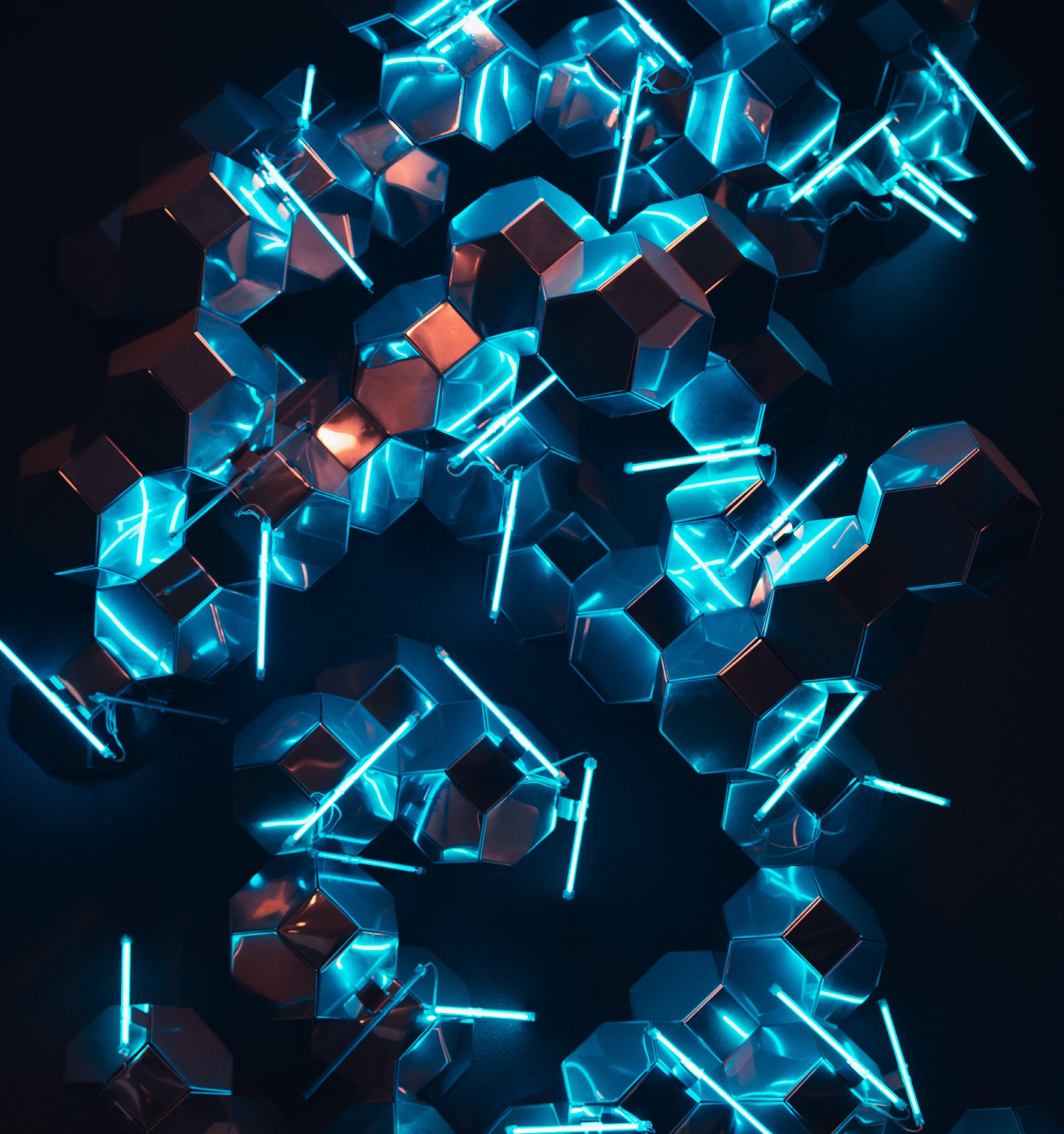
SCIENCE & MATHEMATICS Deep Brain Stimulation: The Context, Complications, and Conversation Sophia Reiner What is Topological Data Analysis? Gyulim Jessica Kang Homeopathy: Myth or Medicine Shreya Srivastava Volatile Organic Compounds Marcus Chin Circadian Rhythm Sleep Disorders Ashley Han Bayes’ Theorem: Updating Belief Sophia Reiner The Science Behind Biogas: Can Society Still Go Green? Rohan Agrawal Introduction to the CRISPR-Cas9 Morgan Ahn Voting Trees Akshay Agarwal The Applications of Artificial Proteins and What It Means for the Future of Medicine Vyjayanti Vasudevan Singing Black Holes Alanna Hattori Genetically Modified Foods Utsa Chaturvedi 08 16 22 26 28 32 38 44 50 54 58 60
Deep Brain Stimulation: The Context, Complications, and Conversation
by Sophia Reiner
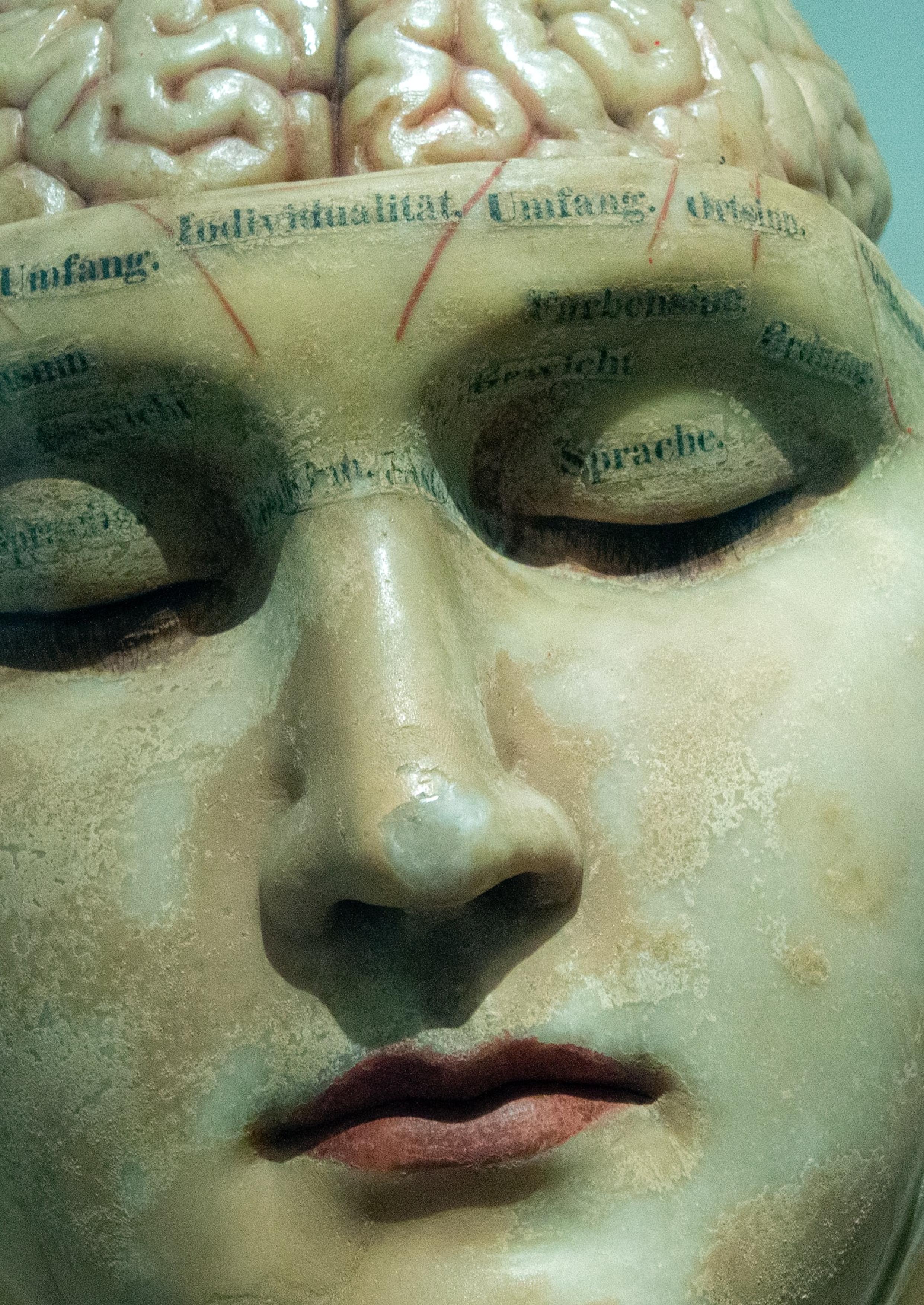 by David Matos on Unsplash
by David Matos on Unsplash
Introduction
It’s the mid-20th century. You’ve been rendered unconscious by the lovely sounding “electro-shock” machine, with the last thing you see before darkness being the white walls of a mental institute. During your slumber, instruments resembling ice picks are shoved through the back of your eye socket and through the thin bone separating the socket from the frontal lobe. In the span of roughly 10 minutes, a hammer is used to tap to handle of the ice picks to cut and scrape away white nerve fibre connections in the brain (Terrier et al., 2019). You wake up and may notice personality changes, epilepsy (Miller, 1967), seizures, cognitive impairment (Healthline, 2022), and more; however, you’re told that you’re lucky that your mental illnesses weren’t severe enough for the surgery to have required drilling holes into your head.
Welcome
modernised by Walter Freeman, created a stigma against psychosurgeries (BBC, 2021; Neumaier et al., 2017). However, the introduction and popularisation of lobotomies were significant in developing safer psychosurgery options. This led to the development of deep brain stimulation (DBS), a neurosurgical treatment through the transmission of electrical impulses to neurological sites; this treatment, like lobotomies, is utilised to regulate chemical imbalances found in movement and mental disorders (American Association of Neurological Surgeons).

These lobotomies, developed firstly by António Egas Moniz (who won a Nobel Prize for his contribution), and
In application, DBS takes place as intracranial electrodes are inserted into the brain, after which a neurostimulator (which transports electric currents) is implanted under the skin, with an
SCIENCE
Photo
to the rest of your lobotomised life!
Deep Brain Stimulation: The Context, Complications, and Conversation
09 08 SPECTRUM VOL.2
Deep Brain Stimulation: The Context, Complications, and Conversation


extension wire connecting the two structures. Additionally, to the internal systems that are stimulated with high frequencies, the external hardware is comprised of a transmitter carried by the patient (National Library of Medicine; Krauss et al., 2020). While the exact underlying mechanisms in DBS are still unknown, Orlando De Jesus of the Neurosurgery Section at the University of Puerto Rico and colleagues (2022) contend that the electrodes deeply placed in the brain, upon activation, either “stimulat[es] or inhibit[es] neurons and fiber pathways that will subsequently allow neurochemical release.” In other words, the specific brain location responsible for each particular disorder is stimulated by electric pulses from the neurostimulator, resulting in a chemical readjustment and alleviation of neurological disorders. Through analysing various viewpoints, this article will conclude that despite
the potential complications, deep brain stimulation is an effective treatment option for both movement and psychiatric disorders.
(inability to maintain balance/ equilibrium) (Fang & Tolleson, 2017). While the first step of Parkinson’s treatment is not DBS but rather pharmacological therapies, Fang and Tolleson (2017) of the Vanderbilt University Medical Center explain the limitations of medications in that “frequent dosing [is required] to avoid the return of symptom.” As a result of these challenges, DBS is FDA approved in select DBS patients (Fang & Tolleson, 2017).
In particular, Schuurman et al. (2000) have discovered that in comparison to
destroyed to treat tremours), DBS of the thalamus has a stronger “functional outcome.” Unlike this treatment with a similar execution to the renounced lobotomy, DBS does not cause permanent impairments.

Impacts on Movement Disorders
Deep brain stimulation is an FDAapproved treatment for Parkinson’s, essential tremors, and epilepsy that treats the physical aspects of neurological disorders.
Deep Brain Stimulation for Parkinson's Disease
Firstly, Parkinson’s (PD) is a “progressive neurodegenerative disorder,” in which a “loss of neuronal dopamine production in the brain” leads to uncontrollable movements such as an asymmetric resting tremor (asymmetric tremor upon muscle relaxation), bradykinesia (slowed movements), and postural instability
Beyond this, Mark Hallet and Werner Poewe (2008) of the National Institutes of Health and the University Hospital of Innsbruck, respectively, state that DBS of the subthalamic nucleus (which has the primary function of regulating movement) is the most effective neural location. The reasons for this are due to DBS in this region being effective on the fundamental symptoms, reducing side effects of the pharmacological treatments, and having low energy consumption (Hallet & Poewe, 2008).
Additionally, in terms of epilepsy, 30% of adults with epilepsy are unable to control their seizures with antiepileptic drugs, becoming candidates for neurostimulation instead (Zangiabadi et al., 2019).
Overall, the use of DBS on Parkinson’s patients indicates that as a last resort, electrodes to the subthalamic nucleus have been the most effective treatment viable – similar to the benefits demonstrated in epilepsy.
Impacts on Psychological Disorders
In addition to movement disorders, other disorders centred in the brain benefit from deep brain stimulation: psychological disorders. The challenges of pharmacotherapy previously described for Parkinson’s also apply to mental treating Parkinson’s with a thalamotomy (in which part of the thalamus is
SCIENCE
Photo by Unsplash
10
VOL.2 11
SPECTRUM
illnesses, as medications for disorders such as schizophrenia, depression, and obsessive-compulsive can lead to “patients becom[ing] refractory [resistant] and will not respond to pharmacologic treatments” (De Jesus et al., 2022) As clinicians have begun evaluating neurosurgical procedures as a final alternative treatment, neuromodulation surgeries have thus gained a larger demographic.

Luka Liebrand of the University of Amsterdam and others (2021) have analysed the use of DBS in treating OCD: 60% of treatment-resistant individuals with OCD respond positively to DBS. Essentially, DBS usage is controlled and offered only when other options are exhausted and has a higher success rate. However, Liebrand (2021) also found that individuals with a larger nucleus accumbens (which works as the “neural interface between motivation and action” (Fernández-Espejo)) volume have a more successful response to DBS treatment.
The reason for this has been hypothesised to be because the electrodes placed in the brain in the larger nucleus accumbens were “closer to the relevant white matter structures” (Liebrand, 2021). While this indicates that drastic improvements as a result of DBS may not be available for entire populations, it provides a guideline for future treatment applications, and optimise the response rate to such treatments.
Furthermore, treatment-resistant depression has been found to have rapid benefits from DBS treatment (50% reduction on a depression rating scale after a week), according to Thomas Schlaepfer and colleagues from the University Hospital Bonn. In accordance, a study reviewing past trials of DBS applied to different parts of the brain to treat treatment-resistant depression has found the “response and remission rates were respectively 56 and 32%” (Wu et al.). This explains that even without a particular location, deep brain
stimulation is significant in treating or at least alleviating the symptoms of OCD. In essence, the evidence for treating OCD and treatment-resistant depression proves that despite the negative perception of psychosurgeries, deep brain stimulation has been able to break barriers and improve psychological symptoms.
Complications of DBS Surgery
Complications of deep brain stimulation can take place in each step of the procedure: during the surgery, as well as during the conclusive effect of the treatment. Firstly, a brain shift could occur during the surgery through the loss of cerebro-spinal fluid (which acts as a cover for the brain) (Slotty et al.); this loss of fluid occurs mostly at the beginning of the surgery as burr holes can be used to balance the intracranial air (Slotty et al). However, after awakening from the surgery, “DBS requires long-term
maintenance for proper functioning” forcing challenges in being cautious after the procedure (Fang & Tolleson, 2017). In addition, hardware complications can also be present, which include “battery failure, problems with the wires, or misplaced electrodes” (Parkinson Alliance). The detrimental effects of this include the cardinal sign of a sudden onset “significant tremor” and other forms of increased disease progression (Farris et al.). However, in a group of 466 patients, 8.1% were found to have impacted motor function skills as a result of hardware problems (Farris et al.). While this is not a significant sized percentage, caution must still be exercised to maintain the efficacy of DBS. In a demonstration of DBS being a successful procedure, Dr. Michael Okun of the University of Florida and more concluded that “51% of patients who complained of “failed” DBS procedures ultimately had good outcomes,” showing a half chance opportunity to reverse any
SCIENCE
Photo by Pawel Czerwinski on Unsplash
12 SPECTRUM VOL.2 13
Deep Brain Stimulation: The Context, Complications, and Conversation
Deep Brain Stimulation: The Context, Complications, and Conversation
mistakes presented.
To focus on specific disorders, in Parkinson’s disease, while movement difficulty can be subsided, DBS can also cause “worse cognition, impaired verbal fluency, depression, cerebral hemorrhage, stroke, and infection among others” (Fang & Tolleson, 2017).
Regarding depression, side effects of infections, headaches, mood changes, and potentially suicidal ideation (only 13%) can also be caused (Moreins et al., 2011). Further emotional changes have been proven in depressed patients who have undergone DBS treatments, as Katherine W. Scangos of the University of California, San Fransisco and colleagues have found. Distinctive emotional changes were found immediately after as patients gained a calmed pleasure or felt excessively drowsy (Scangos et al.).
Together, this states that many types of complications can be resulted from DBS treatment, creating more of a debate as to whether the use of DBS is consistently effective.
Conclusion
Overall, due to the benefits deep brain stimulation has in treating movement and mind disorders that would not otherwise be successfully treated, DBS is an effective treatment option despite current complications. In summary of the previous arguments, the insertion of electrodes that then have an electric current passing through to specialised neural areas has been found to rebalance the chemicals and remove symptoms
from neurological-based disorders. However, in addressing the issue of complications, the explained half per cent chance of reversing complications and the strict regulations that only individuals in treatment-resistance disorders are allowed to use DBS as a treatment both demonstrate medical ethics and ensure the non-maleficence and beneficence are both fulfilled.
In finality, as DBS is an ongoing neurosurgical intervention, it has the opportunity to strengthen neurosurgery and reintroduce psychosurgery as a treatment for disorders which do not benefit from pharmacological medications; deep brain stimulation is helping the world continue to make advancements in medicine – standing up to previously deteriorative disorders.
References
BBC. (2021, January 30). Lobotomy: The brain op described as 'easier than curing a toothache'. BBC News. Retrieved November 14, 2022, from https://www.bbc.com/news/ stories-55854145
Deep Brain Stimulation. AANS. (n.d.). Retrieved November 8, 2022, from https://www.aans.org/en/Patients/ Neurosurgical-Conditions-and-Treatments/Deep-BrainStimulation#:~:text=DBS%20is%20a%20surgical%20interv ention,obsessive%2Dcompulsive%20disorder%20and%20 epilepsy
Deep Brain Stimulation for Movement Disorders | National Institute of Neurological Disorders and Stroke. (2022). Retrieved 7 November 2022, from https://www.ninds.nih. gov/health-information/disorders/deep-brain-stimulationmovement-disorders#:~:text=Deep%20brain%20 stimulation%20(DBS)%20is,slowed%20movement%2C%20 and%20walking%20problems
Deep brain stimulation hardware complications: The role of electrode impedance and current measurements. - The Parkinson Alliance. (2022). Retrieved 7 November 2022, from https://www.parkinsonalliance.org/research-insights/deepbrain-stimulation-hardware-complications-the-role-ofelectrode-impedance-and-current-measurements/ Dyskinesia. (2022). Retrieved 7 November 2022, from https://www.michaeljfox.org/news/ dyskinesia#:~:text=Dyskinesia%20is%20uncontrolled%2C%20 involuntary%20movement,aim%20to%20help%20avoid%20 dyskinesia
Encyclopedia, M., & stimulation, D. (2022). Deep brain stimulation: MedlinePlus Medical Encyclopedia. Retrieved 7 November 2022, from https://medlineplus.gov/ency/ article/007
Fang, J., & Tolleson, C. (2017). The role of deep brain stimulation in Parkinson’s disease: an overview and update on new developments. Neuropsychiatric Disease And Treatment, Volume 13, 723-732. doi: 10.2147/ndt. s113998
Farris, S., Vitek, J., & Giroux, M. L. (2008). Deep brain stimulation hardware complications: the role of electrode impedance and current measurements. Movement disorders official journal of the Movement Disorder Society, 23(5), 755–760. https://doi.org/10.1002/mds.21936
Fernández-Espejo E. (2000). Cómo funciona el nucleus accumbens? [How does the nucleus accumbens function?]. Revista de neurologia, 30(9), 845–849.
Frey, J., Cagle, J., Johnson, K., Wong, J., Hilliard, J., & Butson, C. et al. (2022). Past, Present, and Future of Deep Brain Stimulation: Hardware, Software, Imaging, Physiology and Novel Approaches. Frontiers In Neurology, 13. doi: 10.3389/ fneur.2022.825178
Hallet, M., & Poewe, W. (2008). Therapeutics of parkinson's disease and other movement disorders. John Wiley & Sons. Jesus, O., Fogwe, D., Mesfin, F., & Das, J. (2022). Neuromodulation Surgery For Psychiatric Disorders. Statpearls Publishing. Retrieved from https://www.ncbi.nlm. nih.gov/books/NBK482366/
Krauss, J., Lipsman, N., Aziz, T., Boutet, A., Brown, P., & Chang, J. et al. (2020). Technology of deep brain stimulation: current status and future directions. Nature Reviews Neurology, 17(2), 75-87. doi: 10.1038/s41582-020-00426-z
Liebrand, L. C., Zhutovsky, P., Tolmeijer, E. K., Graat, I., Vulink, N., de Koning, P., Figee, M., Schuurman, P. R., van den Munckhof, P., Caan, M. W. A., Denys, D., & van Wingen, G. A. (2021). Deep brain stimulation response in obsessive–compulsive disorder is associated with preoperative nucleus accumbens volume. NeuroImage: Clinical, 30, 102640. https://doi.org/10.1016/j.nicl.2021.102640
Miller, A. (1967). The Lobotomy Patient—A Decade Later: A Follow-up Study of a Research Project Started in 1948. Canadian Medical Association Journal, 96(15), 1095. Retrieved from https://www.ncbi.nlm.nih.gov/pmc/articles/ PMC1922743/
Moreines, J. L., McClintock, S. M., & Holtzheimer, P. E. (2011). Neuropsychologic effects of neuromodulation techniques for treatment-resistant depression: A Review. Brain Stimulation, 4(1), 17–27. https://doi.org/10.1016/j.brs.2010.01.005
Neumaier, F., Paterno, M., Alpdogan, S., Tevoufouet, E. E., Schneider, T., Hescheler, J., & Albanna, W. (2017). Surgical approaches in psychiatry: A survey of the world literature on Psychosurgery. World Neurosurgery, 97. https://doi. org/10.1016/j.wneu.2016.10.008
Schuurman, P. R., Bosch, D. A., Bossuyt, P. M. M., Bonsel, G. J., van Someren, E. J. W., de Bie, R. M. A., Merkus, M. P., & Speelman, J. D. (2000). A comparison of continuous thalamic stimulation and thalamotomy for suppression of severe tremor. New England Journal of Medicine, 342(7), 461–468. https://doi.org/10.1056/nejm200002173420703
Sironi, V. A. (2011). Origin and evolution of deep brain stimulation. Frontiers in Integrative Neuroscience, 5. https:// doi.org/10.3389/fnint.2011.00042
Slotty, P. J., Kamp, M. A., Wille, C., Kinfe, T. M., Steiger, H. J., & Vesper, J. (2012). The impact of brain shift in deep brain stimulation surgery: Observation and obviation. Acta Neurochirurgica, 154(11), 2063–2068. https://doi.org/10.1007/ s00701-012-1478-y
U.S. National Library of Medicine. (n.d.). Deep Brain Stimulation: Medlineplus medical encyclopedia. MedlinePlus. Retrieved November 14, 2022, from https:// medlineplus.gov/ency/article/007453.htm

What is a Lobotomy? Risks, History and Why It’s Rare Now. (2022). Retrieved 7 November 2022, from https://www. healthline.com/health/what-is-a-lobotomy#risks
Wu, Y., Mo, J., Sui, L., Zhang, J., Hu, W., & Zhang, C. et al. (2021). Deep Brain Stimulation in Treatment-Resistant Depression: A Systematic Review and Meta-Analysis on Efficacy and Safety. Frontiers In Neuroscience, 15. doi: 10.3389/ fnins.2021.655412
Zangiabadi, N., Ladino, L., Sina, F., Orozco-Hernández, J., Carter, A., & Téllez-Zenteno, J. (2019). Deep Brain Stimulation and Drug-Resistant Epilepsy: A Review of the Literature. Frontiers In Neurology, 10. doi: 10.3389/fneur.2019.00601
SCIENCE
14 SPECTRUM VOL.2 15
Ronald H. Coase, a British economist and author of Essays on Economics and Economists, once said: “If you torture the data long enough, it will confess.” This quote will resonate with anyone who’s tried data analysis before. Even though data is abundant in modern society, it’s often inconsistent and scattered across various sources.
What Is Topological Data Analysis?
 by Gyulim Jessica Kang
by Gyulim Jessica Kang
Data analysis is the process of assembling a jumbled jigsaw puzzle, piece by piece, to arrive at the bigger picture: the reason why the data matters.

In pursuit of achieving ever more efficient data analysis, new and improved data analysis techniques continue to spawn in the market. Rooted in persistent homology and the premise that the shape of a dataset contains relevant information, topological data analysis, or TDA, is one of the most exciting latest arrivals.
What is Persistent Homology?
Persistent homology is a method for uncovering topological features from data. What is topology? Topology is a glorified term for a mathematics branch that studies shapes and spaces. What happens when we allow geometric objects to be crumpled, twisted, stretched, and squeezed? Surprisingly, quite a few properties are preserved, and the study of these deformations and their geometric features is topology’s primary focus.
The application of persistent homology in data science provides a robust theoretical foundation for a mathematically rigorous analysis of shape within data (Carlsson, 2009). The shape of the data can be interpreted in several forms depending on the data type. For example, let’s say we have data consisting of a finite number of points scattered in the coordinate space; naturally, you start thinking about how these points are roughly shaped or clustered.
Photo by Vincent Schwenk on Unsplash
MATHEMATICS
Is
Data
What
Topological
Analysis?
Photo by Hofer Teresa on Unsplash
17 16 SPECTRUM VOL.2
This tendency is similar to how we look up at an unusually clear evening sky and see constellations in the shapes of polar bears or scorpions. It’s a human instinct to extract familiar, meaningful shapes from seemingly random and scattered data. TDA aims to encode the persistent homology of a dataset in visual representations accessible to human beings. Ultimately, TDA uses homology to answer meaningful questions such as ‘How can we identify geometric features from data?’ and ‘How do we know that these geometric features are significant?’

Key Concepts
Simplicial Complex
A simplex is the generalization of a triangle, the fundamental shape of geometry, in multidimensional spaces. For example, a 0-simplex is a point, a 1-simplex a line, a 2-simplex a triangle, a 3-simplex a tetrahedron, and so on (Koplik, 2022). Within TDA, we can use persistent homology to translate data into a collection of triangles: a simplicial complex.
1. We first draw a circle around each data point with a radius of δ.
2. If δ is greater than the distance between two points in the data, which would mean the intersection of two circles includes both their centers, we connect the two center points with a line segment.
3. If two balls overlap we connect the corresponding points with a line, or a 1-simplex. If three balls overlap, we fill in the area between them to form a triangle, or a 2-simple.
This continues in the same pattern for subsequent intersections and simplices. Through the simplicial complex, we
derive the homology group, composed of connected components, holes, and cavities (Garin & Tauzin, 2019). H0 commonly represents the group of connected components, H1 the group of holes, and H2 the group of cavities.
Let’s test this process by creating a plot of our own! First, we use a Numpy array to generate 8 random points for our point cloud.

MATHEMATICS
Is Topological Data Analysis?
What
(Talebi, 2022) 18 SPECTRUM VOL.2 19
CLICK TO VIEW VIDEO
The visualizations in the video above reveal the transformation of the simplicial complex as the epsilon, or radius value grows. As the overlap between the circles increases, more and more connected components (H0) and holes (H1) are birthed within the complex. Triangles and edges appear, merge, and disappear with the change of epsilon. Additionally, the total number of components decreases over time; if epsilon is sufficiently large, there will eventually only be one united connected component remaining in the simplex. In summary, the number of components and holes can be important indicators of key geometric features, and we can obtain them by computing the homology of the complex.

the epsilon value, or radius, changes to extract meaning from data.
Conclusion
In closing, persistent homology has many applications in data science. Persistent homology is the primary method used in TDA to study qualitative features of data that persist across multiple scales. It has countless advantages as well; it’s robust to perturbations of input data, independent of dimensions and coordinates, and provides a compact representation of the qualitative features of the input. For future work, I would like to dive deeper into the mathematical background of persistent homology along with the various applications of TDA in real life.
From the Vietoris-Rips complex, we were able to achieve geometric intuition. However, if we only consider one Vietoris-Rips complex, we can’t know for sure which epsilon value best represents the shape of data. For every epsilon value, we must be able to summarize how the number of components and holes shift. The concept of persistent homology originated from this idea. Building on our previous definition, we can define persistent homology as the concept of measuring which homological features die are born from a simplicial complex as
References
Carlsson, Gunnar. "Topology and data." Bulletin of the American Mathematical Society 46.2 (2009): 255-308.
Garin, A., & Tauzin, G. (2019, December). A topological" reading" lesson: Classification of MNIST using TDA. In 2019 18th IEEE International Conference On Machine Learning And Applications (ICMLA) (pp. 1551-1556). IEEE.
Koplik, G. (2022, June 16). Persistent homology: A NonMathy Introduction with Examples. Medium. Retrieved July 5, 2022, from https://towardsdatascience.com/persistenthomology-with-examples-1974d4b9c3d0
Talebi, S. (2022, June 17). Persistent Homology. Medium. Retrieved July 6, 2022, from https://medium. datadriveninvestor.com/persistent-homologyf22789d753c4

MATHEMATICS
What Is Topological Data Analysis? 20 SPECTRUM VOL.2 21
by Shreya Srivastava
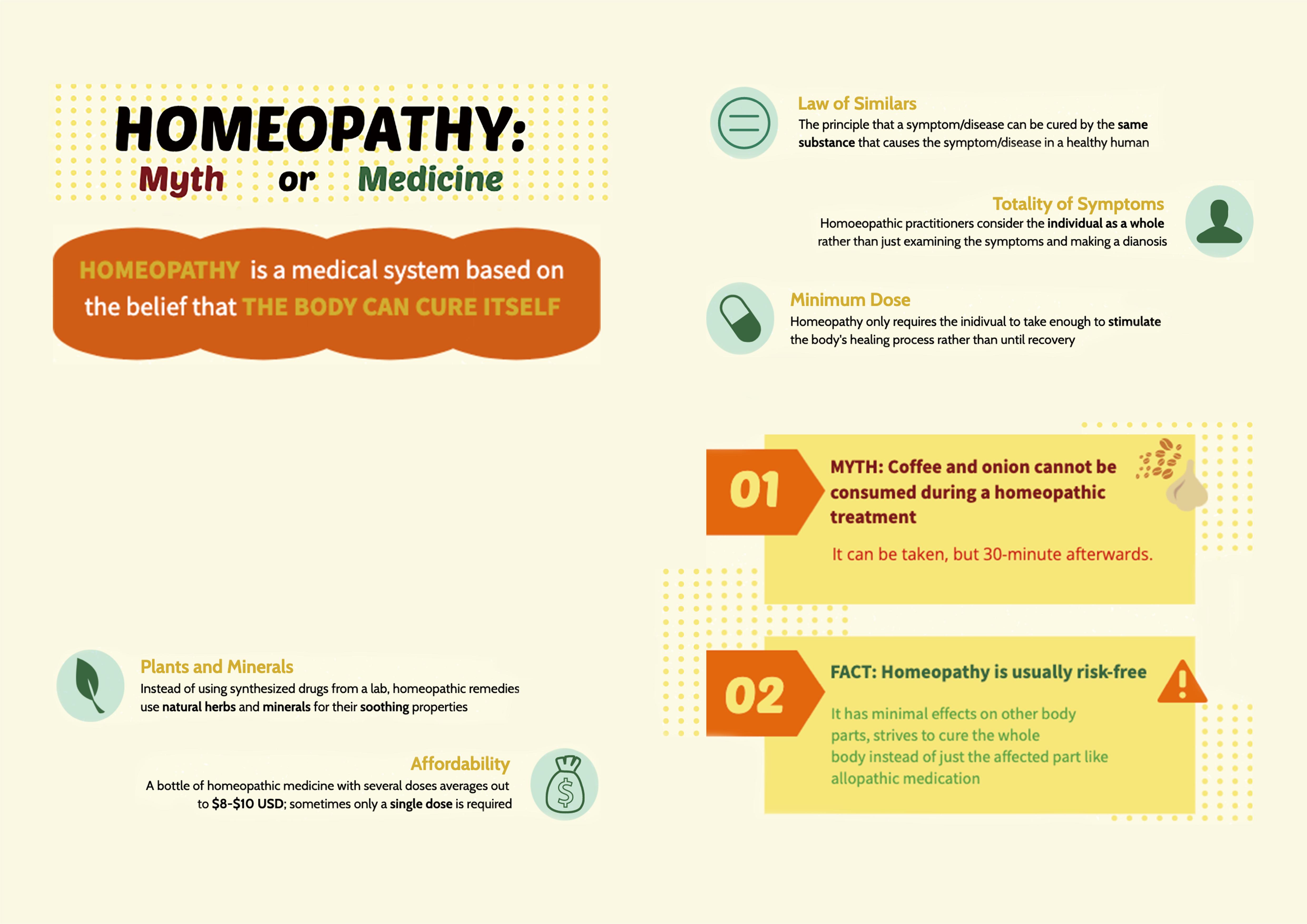
Homeopathy: Myth or Medicine SCIENCE 22 SPECTRUM VOL.2 23

Homeopathy: Myth or Medicine SCIENCE 24 SPECTRUM VOL.2 25
References
Araoye, T. O. (2018, January). (PDF) a comparative analysis Allen Stewart, P.C. (2018, July 10). The History of Benzene Use Benzene Exposure Lawyer. Allen Stewart PC. https://www. allenstewart.com/practice-areas/ benzene-exposure/the-history-ofbenzene-use/ Huertas, J. I., Magaña, M., Huertas, M. E., Cárdenas, B., Watanabe, T., Maeda, T., Wakamatsu, S., & Blanco, S. (2015). Volatile organic compounds in the atmosphere of Mexico City. Atmospheric Environment, 119, 415–429. https://doi.org/10.1016/ j.atmosenv.2015.08.014

Volatile Organic Compounds (VOCs) | U.S. Geological Survey. (2019, February 28). https://www.usgs.gov/missionareas/water-resources/science/ volatile-organic-compounds-vocs
VOLATILE
 by Marcus Chin
by Marcus Chin
The industrial odor is a distinctive smell that everyone close to it will notice. At first, most would find the scent to be acrid, but upon closer examination, some may find the scent to be somewhat pleasant. However, this scent is deceiving. The hydrocarbons found inside gasoline are mostly volatile organic (carbonbased) compounds, or VOCs for short. VOCs have a low vapor pressure, which means many molecules can escape into the surrounding air, allowing them to be inhaled by us. The issue with VOCs is that many of them are toxic, and some are even carcinogenic (cancer-causing).
One of the most infamous VOCs is benzene, which is the chemical that gives gasoline its pleasant scent. Despite its extremely low concentration in gasoline, benzene is what makes people actually like the gassy smell. This is not anything surprising - in the 19th and 20th centuries, benzene was added to aftershave to give it a sweet smell and also used as an organic solvent to decaffeinate coffee (Allen Stewart, P.C., 2018). However, over the last century, benzene has slowly been phased out of virtually all consumer products. Benzene’s disappearance is for good reason though; after years of benzene-exposed workers continuously being diagnosed with leukemia, a link between benzene and leukemia was finally established, and benzene was classified as a human carcinogen.
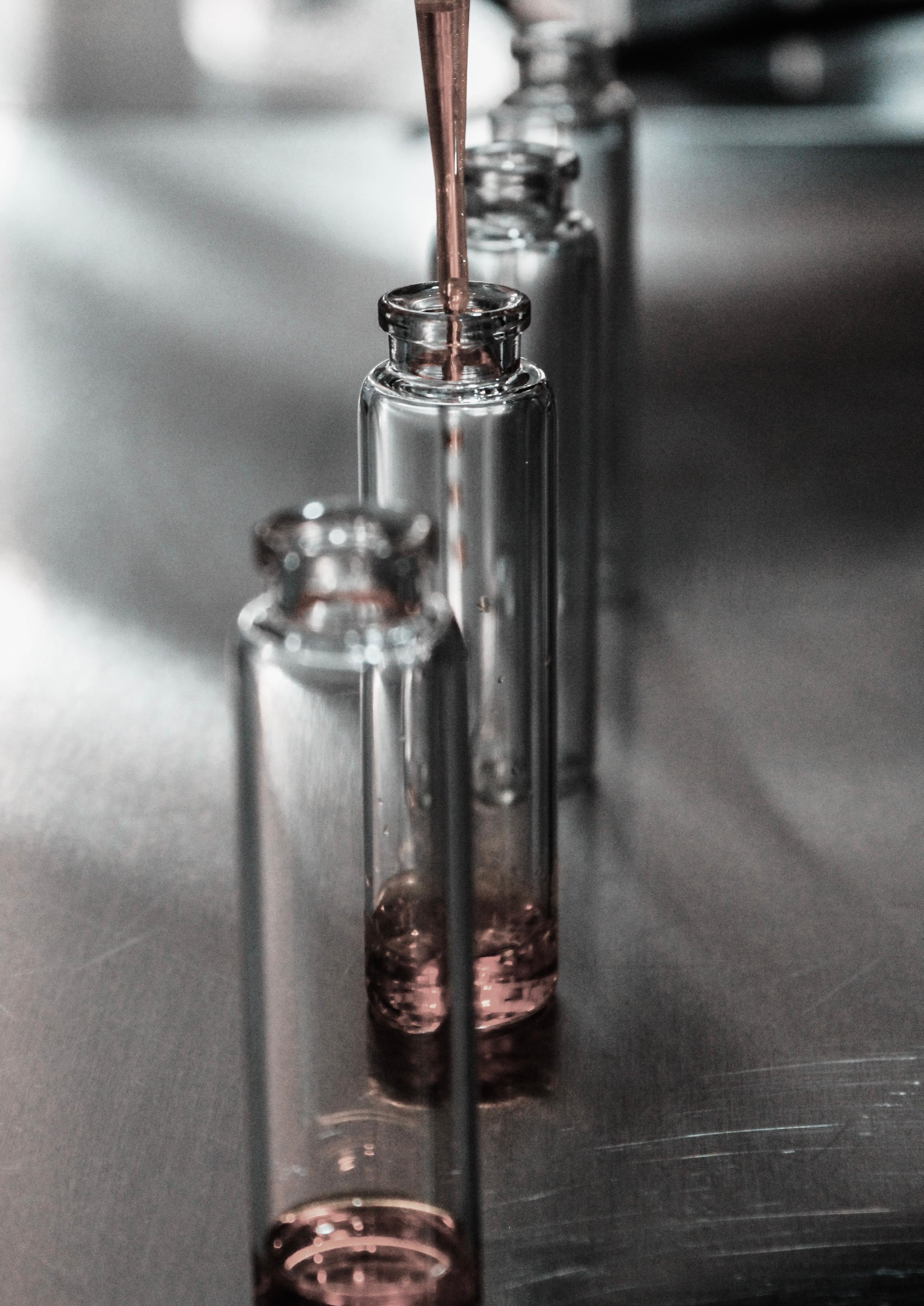
booster in gasoline (Volatile Organic Compounds (VOCs) | U.S. Geological Survey, 2019). More concerningly, in some cities like Mexico City, benzene levels still remain above the permissible limit of one part per billion (Huertas et al., 2015). The prevalence of these VOCs poses both a health issue to humans as a carcinogen and an environmental issue, polluting the air surrounding industrial sectors.
Photo by Fulvio Ciccolo on Unsplash
Even with benzene mostly eradicated from everyday items, other dangerous VOCs continue to plague our society. VOCs like trihalomethanes, many of which are carcinogens, inevitably appear in groundwater as a result of organic waste. Other VOCs like methyl tert-butyl ether have been an issue for decades, sneaking their way into water wells after they started to be used as a replacement for lead as an octane
As society shifts to a greener future, we can only hope that our planet will too, slowly repairing the damage that dirty industrial development has caused. However, what we can do is protect ourselves against the harmful VOCs within our homes. Products such as paint thinners and oil-based paints still contain high levels of toluene, which can cause acute respiratory issues if not handled properly. While alternatives such as citrus-based thinners have been made, their efficacy is proven to be much worse than traditional lacquer thinners and, unfortunately, not viable for large-scale projects. By monitoring the contents of the products we use and keeping rooms well-ventilated, potential exposure risks can be minimized, and we can at least keep ourselves safe against the VOCs that still thrive.
Have you ever smelled gasoline before?
SCIENCE Volatile Organic Compounds
27 26 SPECTRUM VOL.2
Circadian Rhythm Sleep Disorders
 by Ashley Han
by Ashley Han
Sleep is one of the most vital functions for not only humans but many organisms on the planet. However, the reason why we need to sleep is still not entirely understood by scientists, and only hypotheses are made (Pomeroy, 2021).
which determines when we feel drowsy or active. By sleeping late, we are significantly delaying our circadian cycle. Our internal clock is put off-balance due to our inconsistent sleeping patterns, which may lead to health problems in the long run. (Suni, 2022)
Despite sleep’s importance, many people choose to take it for granted.
Whether it’s by pulling all-nighters caught up with binge-watching shows or getting little to no sleep due to schoolwork, many people are unaware of the consequences that lack of sleep may have on any internal functions—such as the circadian rhythm. The circadian rhythm is a natural process that repeats every 24 hours inside the body. This process regulates the sleep-wake cycle,
The naturally-secreted hormone that controls our drowsiness is melatonin, known as the “sleep hormone.” This hormone is located in the pineal gland in our brain and is released in the brain. Since melatonin is responsive to darkness, its levels vary depending on the time of day. If it’s daytime, there would be significantly less melatonin production compared to the nighttime, where melatonin would continue to be secreted until the next day (Cleveland Clinic, 2022). This is the reason why people who have struggles sleeping take syntheticallyproduced melatonin capsules to aid in sleep.
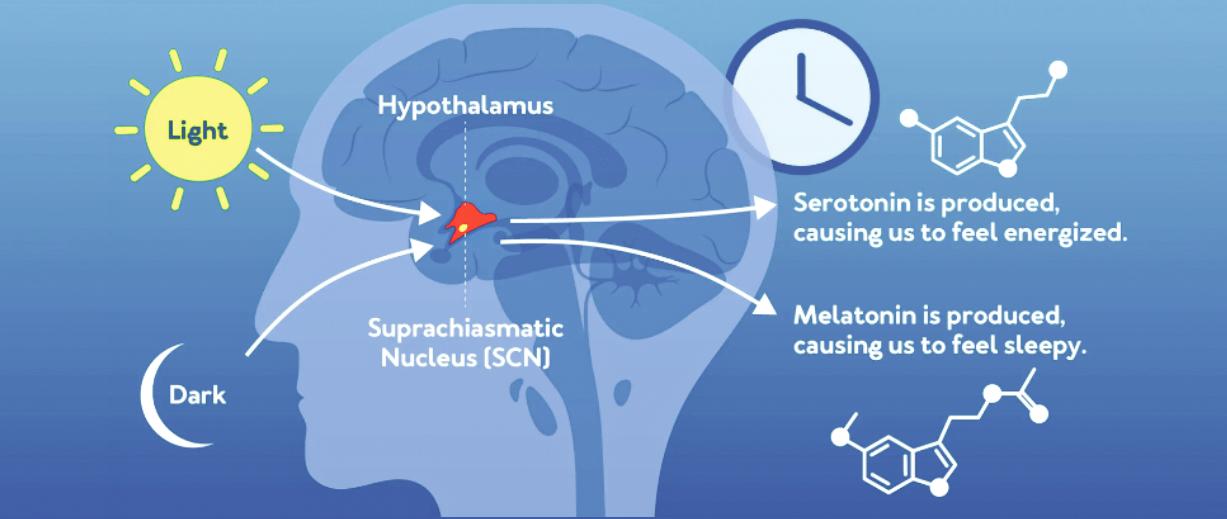
SCIENCE
Circadian Rhythm Sleep Disorders
Photo by Hayley Murray on Unsplash
29 28 SPECTRUM VOL.2
The circadian clock, responsible for the circadian rhythm, is located in the suprachiasmatic nucleus (SCN) in the hypothalamus—a structure in the brain responsible for maintaining the body’s homeostasis. The SCN, which delivers information for melatonin production to the brain, is located above the optic nerves and controls the production of melatonin depending on the intensity of light. (Jones, 2013)
Circadian rhythm sleep disorders (CRSDs) throw the sleep-wake cycle off balance by causing significant decreases in melatonin levels during the night and increases in melatonin production during the daytime, resulting in excessive daytime sleepiness and poor sleep quality. CRSDs can also lead to decreased alertness and struggles with decisionmaking and eventually lead to chronic obesity and depression. (Suni, 2022) Fortunately, not all CRSDs are severe,
and most of us have experienced one form of a circadian rhythm disorder at some point in our lives. One of the most common types of CRSDs is jet lag. When people travel from one time zone to another by air, the circadian rhythm is knocked off balance and needs to adjust to the new time zone. Another type of CRSD is the delayed sleep phase disorder, which means that someone goes to sleep later and wakes up later. These kinds of people are more productive during the night and experience drowsiness if forcefully woken up (Cleveland Clinic, 2020)
A possible treatment for CRSDs is bright light therapy (BLT). BLT is conducted by exposing the patient to a certain amount of light for a period of time (U.S. Department of Health and Human Services, 2022). This treatment resets the unbalanced internal clock by using the light to mimic sunlight. The results of this
are shown in one of the types of BLT— the dawn simulator. The patient sits in a dark room where lights gradually turn on to mimic sunrise. Some treatments also mimic a sunset by slowly dimming the lights. This has been shown to have helped patients wake up in the morning and fall asleep at night (Hershner, 2021)
With more insight into the concept of sleep than before, scientists have created many treatments to aid people in sleeping comfortably at night. Recently, there have been studies exploring the relationship between Parkinson’s and sleep disorders and potential treatment methods. With this new discovery, it is promising that scientists will discover more about sleep in the near future.

References
Cleveland Clinic. (2020). Circadian rhythm sleep disorders: Types, symptoms and management. Cleveland Clinic. Retrieved November 7, 2022, from https://my.clevelandclinic. org/health/diseases/12115-circadian-rhythm-disorders
Cleveland Clinic. (2022). Melatonin: What it is & function. Cleveland Clinic. Retrieved November 7, 2022, from https://my.clevelandclinic.org/health/articles/23411melatonin#:~:text=Melatonin%20is%20a%20natural%20 hormone,effects%20on%20the%20human%20body
Hershner, S. (2021, May 6). Bright Light Therapy. Sleep Education. Retrieved November 7, 2022, from https:// sleepeducation.org/patients/bright-light-therapy/
Landgraf, B. (2022, March 14). Circadian rhythm: What it is, why it's important, and how to fix/maintain yours. Carex. Retrieved November 8, 2022, from https://carex.com/blogs/ resources/circadian-rhythm
Jones, C. R., Huang, A. L., Ptáček, L. J., & Fu, Y. H. (2013). Genetic basis of human circadian rhythm disorders. Experimental neurology, 243, 28–33. https://doi.org/10.1016/ j.expneurol.2012.07.012
Pomeroy, R. (2021, November 1). Why do we sleep? Scientists still don't know. Big Think. Retrieved November 7, 2022, from https://bigthink.com/health/why-we-sleep/
Suni, E. (2022, November 4). Circadian rhythm. Sleep Foundation. Retrieved November 7, 2022, from https://www. sleepfoundation.org/circadian-rhythm#:~:text=Without%20 the%20proper%20signaling%20from,%2C%20and%20 lower%2Dquality%20sleep
U.S. Department of Health and Human Services. (2022). Circadian Rhythm Disorders Treatment. National Heart Lung and Blood Institute. Retrieved November 7, 2022, from https://www.nhlbi.nih.gov/health/circadian-rhythmdisorders/treatment#:~:text=The%20most%20common%20 treatments%20are,eligible%20for%20a%20clinical%20trial
SCIENCE
Circadian Rhythm Sleep Disorders
30 SPECTRUM VOL.2 31
Photo by Quin Stevenson on Unsplash
Bayes' Theorem: Updating Belief
 by Aaron Brest
by Aaron Brest
I’ll pose a famous question made SAS-centric. I picked a student from high school who I tell you is shy and introverted. Do you expect them to be in Model United Nations (MUN), or Math Club?
A common thinking process is that because MUN is an activity centered around public speaking, a shy and introverted person probably wouldn’t thrive there and thus wouldn’t be a part of it. They’d be in the Math Club. This is a good line of reasoning—from my experience, people in the field of mathematics tend to be more socially uncomfortable than diplomats, so:
But a key piece of information that I’ve neglected to tell you is the number of people in each club.
- Math Club has about 20 active members, according to the avg. of Frank - Xie and Kangmin Kim’s responses

MUN has about 100 active members, according to Sean Lai
In our quest for evaluating the likelihood of a shy and introverted person to be in Math Club or MUN, we forgot to incorporate other pieces of information into our thought process. With the memberships in mind, we can construct a probability table to show the relative likelihoods.
- Let’s assume that 75% of Math Club members are shy (made up) - Let's assume that 15% of MUN members are shy (made up)
If we know the person is shy and introverted, he ultimately only has a probability of 1540 or 37.5% that he’s in MC.
Photo by Ashkan Forouzani on Unsplash
MATHEMATICS
Belief 33 32 SPECTRUM VOL.2
Bayes' Theorem: Updating
It turns out that there isn’t a need to table out our data when facing a problem such as this one. Bayes’ theorem, recorded to be derived in the middle 18th century, is a systematic way to get these comprehensive probabilities. It’s derivation begins with the equation for conditional probability, which Precalculus students will be familiar with:
This equation has applications beyond gauging the probability of club membership. I’ll pose another question. You are a doctor and your patient is tested positive for a terrible cancer, and you are aware that having cancer almost guarantees having the flu. Let’s assume that:
- 99.999999% of cancer-afflicted patients have a cough (made up)
- 20% of flu-afflicted patients have a cough (made up)
- 0.003% of the population has cancer (avg. of male & female rates from NCI, 2020 multiplied by 10)
- 7% of the population have the flu (CDC, 2010-2020)

Let’s find the likelihood that our coughing patient has cancer.
And when we replace probability of A and B with the expression on the left, we get the below, Bayes’ Theorem:

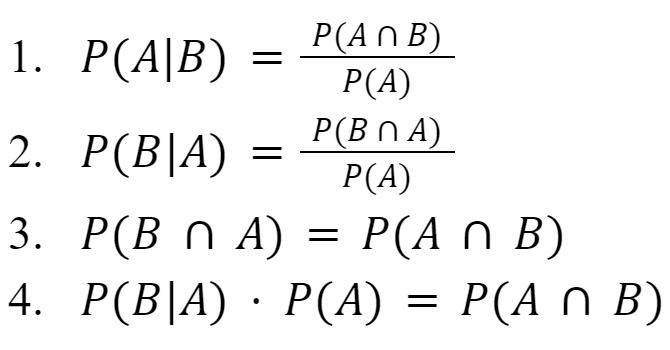
Semantically, this equation reads that the probability of A given B is equal to the probability of B given A multiplied by probability of A all over probability of B. Taking the example of the student above, let’s calculate the probability of him being in Math Club with Bayes’ Theorem.



Despite the fact that a cancer patient is guaranteed a cough, there’s only a 0.043% probability that a coughing patient has cancer.
This leads us into today’s actual topic—not an equation, but a way of thinking. For less scientific propositions like “McDonalds is a bad restaurant,” Bayes’ rule serves as a new way to incorporate evidence to prove or disprove a claim. Normally, we have a standing opinion for these sorts of qualitative assertions, but we remain unflinching until we face a substantially powerful piece of evidence to reverse our notion; Bayes’ Theorem allows us to treat these opinions as slidable values of beliefs, which we can constantly shift with new evidence.
MATHEMATICS
Photo by Ashkan Forouzani on Unsplash
Photo by Sven Miekeon Unsplash
34 VOL.2 35
Bayes' Theorem: Updating Belief
SPECTRUM
Let’s suppose I think that McDonalds is a bad restaurant—I’m not a McFan. One day, a friend of mine tells me that out of the 100 orders he’s placed in McDonalds, 40 orders were incorrect. That’s a pretty bad tally—40% of his orders were served incorrectly. How much should this piece of evidence cement my McDonald’sdisliking persuasions? Let’s find out:
Now let’s go back to McDonalds. Since the probability of getting an incorrect burger given McDonalds is 0.4, and the probability of getting an incorrect burger at McDonalds given our current opinion of McDonalds is a similar value, we can claim
that will be a bit larger than one. Our friend’s struggle with McDonalds isn’t that significant of a piece of evidence.
I know that this is messy, but we need some way to link probability of faulty orders to badness. Essentially think of P(McDonalds is bad) as our standing opinion of McDonalds, with values near-0 representing belief that McDonalds is not bad, and vice versa.
We already have the probability of an incorrect order given that the restaurant is McDonalds, 0.4, but you’d hopefully realize that this would be quite similar to the probability of an incorrect order given McDonalds, given our current opinion of McDonalds—I think of McDonalds as unfavorable, and this evidence does not reveal a more favorable McDonalds.

Before we go on, try to think about what we are doing when we apply Bayes’ rule to a proposition and a piece of evidence. In McDonald’s terms, the probability of McDonalds being a bad restaurant given the probability of an incorrect order at McDonalds is equal to the probability of an incorrect order at McDonalds given that McDonalds is bad divided by the probability of an incorrect burger at McDonalds multiplied by our prior belief that McDonalds is bad.
That’s a lot to unpackage, but the key concept here is that serves as a scalar for our prior belief. This is the updator of P(A). If is less than one, the evidence has proven our proposition less likely. If is greater than one, the evidence has made our proposition less likely.
This method of updating our beliefs is formally referred to as Bayesian inference. Pedantics aside, this method reveals that probability can be interpreted as a degree of belief—being a “Bayesian” shouldn’t mean that you are plugging values into the theorem, but it means that you should keep values of in mind.





How more does event B happen given A than under normal circumstances? Ultimately, this quotient shows the strength of new evidence—how you should update your prior belief.
References
Laplace, P.-S. de. (1774). Oeuvres Complètes De Laplace. Gallica. Retrieved November 21, 2022, from https://gallica. bnf.fr/ark:/12148/bpt6k77596b/f284.image
Source shows Pierre-Simon de Laplace’s discovery of Rev. Thomas Baye’s theorem. Detailed on page 29. For a quick history, Bayes essentially conceived of the equation, and Laplace refined the math and pioneered the modern thinking surrounding it.
Further Reading
Bayes, T., & Price, R. (1763). An Essay towards Solving a Problem in the Doctrine of Chances (Vol. 53). Hafner. Laplace, P. S., Truscott, F. W., Emory, F. L., & Bell, E. T. (1902). A
Philosophical Essay on Probabilities. Dover Publications.
MATHEMATICS 36 SPECTRUM VOL.2 37
Bayes' Theorem: Updating
Belief
The Science Behind Biogas: Can Society Still Go Green?
 by Rohan Agrawal
by Rohan Agrawal
The extensive use of fossil fuels, especially within the last 60 years, has affected economic and environmental sectors on a global scale. Fossil fuel
consumption hasn’t simply doubled or tripled but “increased around eight-fold since 1950” (Ritchie, 2022).
Now, how exactly is this sustainable? Understandably, many global firms in this post-industrial society rely heavily on fossil fuels. Byproducts of fossil fuels— including petroleum to fuel cars and gas to heat food—have become the crux of happy living.

What is even more shocking is that the United States, China, and India, when combined, consume more fossil fuels than all other countries in the world put together.
With approximately “84% of the world's energy consumption needs being met through fossil fuels alone," it should be no surprise that such an energy source will run out within this century (Kumar, 2021). Therefore it is critical that countries, primarily MEDCs that rely on oil production, shift towards renewable energy: in particular, biogas.
What is Biogas?
Biogas is a renewable energy source composed of organic matter, such as food waste or animal waste, which is inevitably decomposed by microorganisms. While
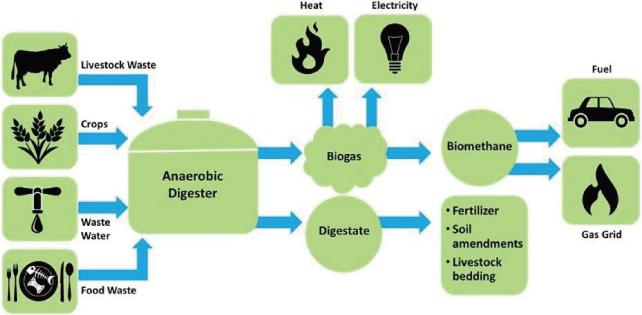
Science Behind Biogas: Can Society Still Go Green?
The
Photo by Deepmind on Unsplash
SCIENCE
39 38 VOL.2 SPECTRUM
the concepts behind biogas only continue to grow apparent, the employment of this energy source is ever expanding— especially amongst farmers and families deprived of electricity. One way biogas can be cultivated is through cows’ and bulls’ manure; therefore, poverty-stricken farmers have swiftly indulged in the opportunity of installing biogas plants. Such a shift has led to affordable and everlasting renewable energy amongst the lower-class public.
Now, even though the process of developing biogas requires little effort, several environmental conditions must first be fulfilled. Initially, organic waste components are dried up before being stored in an anaerobic digester. Aside from organic waste, water and bacteria (methanogens) also settle in the digester for fermentation. The digestor must also be preserved in an airtight container, left warm and undisturbed.
Methanogens are extremely temperature sensitive, with the optimum temperature for biogas production at 35°C. The activity and growth rate of this bacteria decrease by 50% for every drop in 10°C (National Library of Medicine, 2012). While the signs of biogas become apparent after 10 days of captivity, the type of organic waste collected truly affects the timing. After organic waste is digested, pipes are attached to the biogas plant to store biomethane gas.
What are the Effects of Biogas?


Electricity has innumerable jobs, including helping to power motorized engines or turns on a stove; likewise, biogas can be harnessed in a similar fashion. Several scientists and analysts have noted that “biogas burns very cleanly and produces fewer pollutants during cooking than any other fuel except electricity” (Energypedia, 2019). Also, unlike fossil fuels, biogas is a renewable energy source, made from organic compounds, therefore there is access to this energy source in the long run. This is why society should advocate for a switch to Biogas. By shifting to biogas, individuals can help combat the imminent climate disaster—caused by astronomically high carbon footprints— since producing biogas doesn't emit greenhouse gasses. Even the byproducts of producing biogas, compost, a nutrient and fertilizer for plants and crops, can benefit the environment. So, why haven’t we shifted to biogas? Despite the several benefits provided by biogas, there are still downsides to this energy source in comparison to fossil
fuels. Due to the lack of technological advancements concerning biogas plants, large-scale production of biogas still remains a milestone; hence, biogas enterprises won't be economically viable. Furthermore, biogas contains impurities. For example, when trying to fuel automobiles, biogas can corrode the engine and lead to high maintenance costs (Evans, 2020). As mentioned before, methanogens responsible for the production of biogas also require a specific optimal temperature, so if the overall temperature drops below the optimal level, external heat needs to be supplied to the digesters.
The Science Behind Biogas: Can Society Still Go Green?
SCIENCE
Photo by Pixabay
40 SPECTRUM VOL.2 41
Photo by David Thielen on Unsplash
How Efficient is Biogas?

Fossil fuels need to be replaced with an eco-friendly energy source, but which energy source is most efficient? Besides biogas, there are several other types of eco-friendly energy sources being explored: solar energy, hydroelectricity, and wind energy. Research departments have conducted experiments that have compared solar energy to biogas energy: “the results deduced that generating energy from biogas is more effective and reliable for the community compared to solar energy" (Araoye, 2018). When comparing hydroelectricity to biogas, both have similar advantages. However, hydroelectricity is more beneficial because "construction costs
can be mitigated by using preexisting structures such as bridges, tunnels, and dams" (Department of Energy). In contrast, biogas provides benefits apart from generating renewable energy. Since biogas is produced using organic waste, this helps tackle the 1.3 billion tonnes of food waste, which remains a pertinent issue today. From an environmental standpoint, society would be better off if we shifted from man-made fuels to biogas. However, biogas isn't an economically viable source for coal and gasoline monopolies; therefore, making such a shift would devastate such industries: Economies are still predominantly reliant on fossil fuels, constituting 80% of the world's energy (EESI, 2021). Still, the implementations of
biogas have begun to surface, especially in the west, with the formation of new intricate biogas plants. Society can’t go green anytime soon, however renewable energy sources like biogas show us that the road to sustainability isn’t as narrow as we thought.
References
Araoye, T. O. (2018, January). (PDF) a comparative analysis of renewable energy using biogas and solar ... Retrieved November 6, 2022, from https://www.researchgate. net/publication/328734110_A_Comparative_Analysis_ of_Renewable_Energy_Using_Biogas_and_Solar_ Photovoltaic_Systems_A_Case_Study_of_Ajaba_In_Osun_ State
Benefits of hydropower. Energy.gov. (n.d.). Retrieved November 6, 2022, from https://www.energy.gov/eere/water/ benefits-hydropower#:~:text=Hydropower%20provides%20 benefits%20beyond%20electricity,to%20other%20 sources%20of%20energy
Cioabla, A. E., Ionel, I., Dumitrel, G.-A., & Popescu, F. (2012, June 6). Comparative study on factors affecting anaerobic digestion of agricultural vegetal residues. Biotechnology for biofuels. Retrieved November 6, 2022, from https://www.ncbi. nlm.nih.gov/pmc/articles/PMC3431276/
Cooking with biogas. energypedia. (n.d.). Retrieved November 6, 2022, from https://energypedia.info/wiki/ Cooking_with_Biogas
Environmental and Energy Swwwwwwwwwwwwtudy Institute (EESI). (n.d.). Fossil fuels. EESI. Retrieved November 6, 2022, from https://www.eesi.org/topics/fossil-fuels/ description#:~:text=Fossil%20fuels%E2%80%94including%20 coal%2C%20oil,were%20compressed%20and%20heated%20 underground
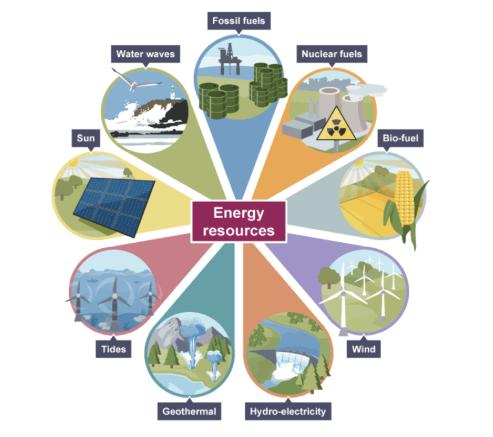
Evans, S., & GlobalData. (2020, January 28). The pros and cons of biogas: Is it the answer to a circular economy? Power Technology. Retrieved November 6, 2022, from https:// www.power-technology.com/analysis/biogas-pros-andcons/
Kumar, H. (2021, February 8). Must-know facts about fossil fuels: Production, consumption and climate change trends. Offshore Technology. Retrieved November 6, 2022, from https://www.offshore-technology.com/analysis/must-knowfacts-about-fossil-fuels/
Ritchie, H., Roser, M., & Rosado, P. (2022, October 27). Fossil fuels. Our World in Data. Retrieved November 6, 2022, from https://ourworldindata.org/fossil-fuels#:~:text=Fossil%20 fuel%20consumption%20has%20increased,many%20 parts%20of%20the%20world
SCIENCE
The Science Behind Biogas: Can Society Still Go Green?
42 SPECTRUM VOL.2 43
Photo by Roger Starnes on Unsplash
Introduction to the CRISPR-Cas9
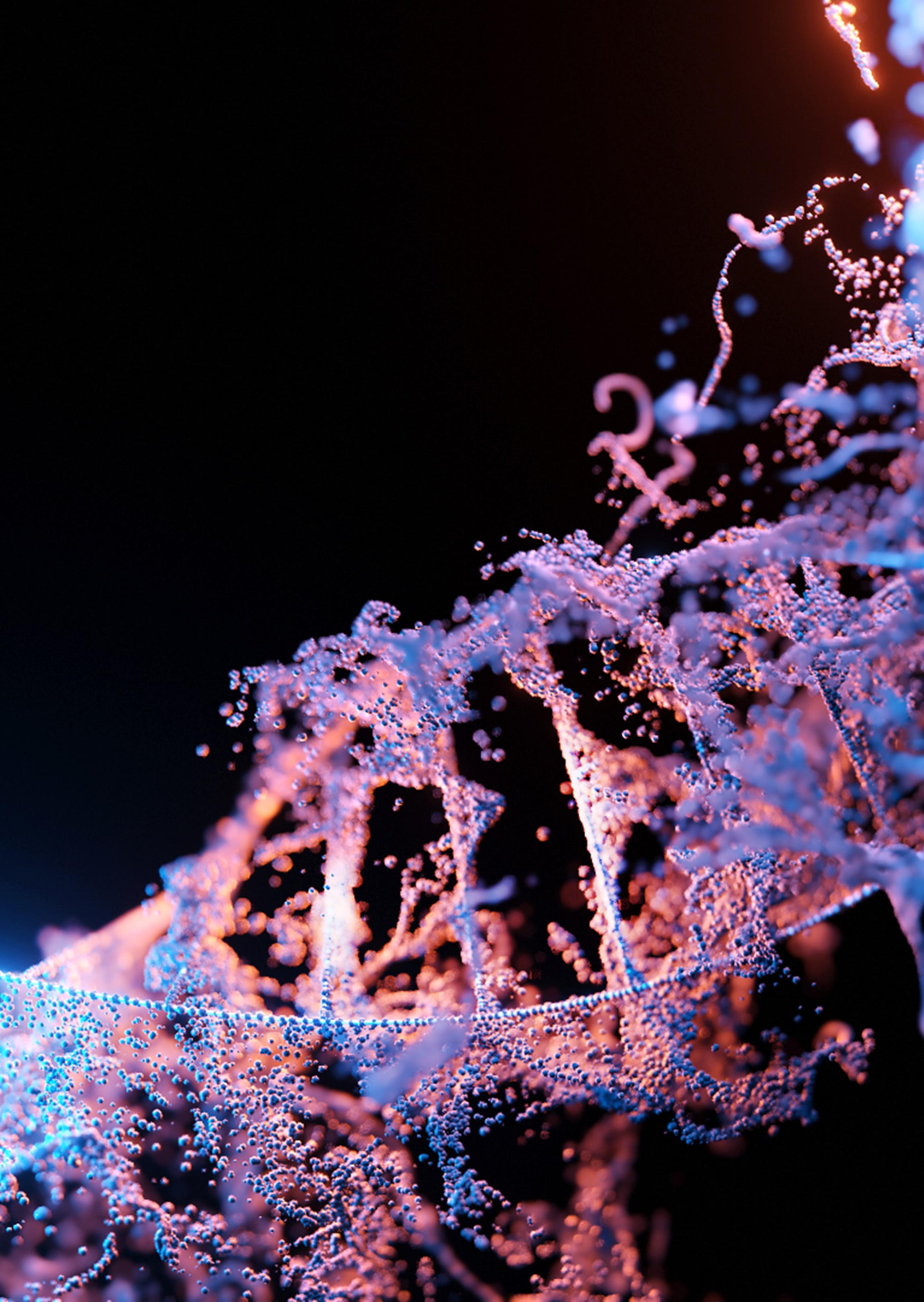 by Morgan Ahn
by Morgan Ahn
C
Overview
Genetic scissors have been a keen interest for scientists – especially medical scientists since it greatly impacts the medical field. This research started in 1985 when Miller discovered the Zinc Finger. He began studying at the TFIIA in 1982 which led him to discover the method to grasp the DNA by binding specific DNA sequences with Zn. After a remarkable discovery, TALEN (Transcription activator-like effector
RISPR-Cas9, often referred to as genetic scissors, is fascinating to me because it is a significant scientific breakthrough so far in the 21st century. Science magazine announced CRISPRCas9 genetic scissors as top 10 innovative technology last 2015: pulling down the limitation for medical treatment. Therefore, I wanted to research not only the ambiguity of this technology but also how it can be applied in a genuine situation.nuclease) was discovered in 2010 by Dan Voytas. This was easier to use than the other technologies and opened the possibility of genome editing. Hence, the research in medicine rapidly progressed, and finally, in 2012, Jennifer Doudna and Emmanuelle Charpentier discovered CRISPR-Cas9. So, what is CRISPR-Cas9, and why do scientists break through the problems?
Structure
CRISPR-Cas9 is able to edit the genome by cutting a specific section of the DNA sequence or rectifying it. However,
45 44 SPECTRUM VOL.2

SCIENCE
Photo by Sangharsh Lohakare on Unsplash the CRISPR-Cas9
Introduction
to
“
CRISPR is an acronym for Clustered Regularly Interspaced Short Palindromic Repeat which is a group of DNA (Deoxyribonucleic Acid) found in genomes of organisms such as bacteria. ”
Photo by National Cancer Institute on Unsplash
there are some differences compared to the previous technology. It does not have a complex protein structure and is capable of cutting DNA deeper and more precisely.
According to The Federal, CRISPR includes a guide RNA (gRNA) which is a “piece of pre-designed RNA sequence located within a longer RNA scaffold.” This can change the genomic target of the Cas enzyme by simply changing its sequence; and, it helps Cas9, an enzyme, to cut the properly planned part of the DNA – prevent cutting off-target –because gRNA has RNA that supports the target DNA sequence.

Occasionally, if gRNA were replaced with other RNA, it can be used as the genetic scissors that can cure other genetic diseases. Scientists were able to discover Cas9 by certain bacteria which have a similar gene-editing system as much as
responding to pathogens. By elaborating on the technology, scientists say it is able to mutate DNA.
Function
The mechanism of the CRISPR-Cas9 genome editing has “three [main] steps: recognition, cleavage, and repair.” (The big bang of genome editing technology: development and application of the CRISPR/CAS9 system in disease animal models) Cas9 protein, which contains six domains – REC I, REC II, Bridge Helix, PAM Interacting, HNH, and RuvC – bind with gRNA and scan DNA sequences to find the particular sequence which is two G bases next to each other. If it finds such a sequence, Cas9 protein extends the double helix to check if it is complementary with gRNA. Under this

condition, Cas9 cuts the strands of the DNA. After Cas9 is activated, the cell tries to minimize the damage by sticking ends together and mutating the end side of the break or searching the matching
sequences to repair the certain deserted location. By the process of finding alternations of the particular sequence, scientists make it possible to set the genome as they desired.
SCIENCE
Introduction to the CRISPR-Cas9 46 SPECTRUM VOL.2 47
There are various advantages that CRISPR-Cas9 brings to us. It can be the “potential tool” for the treatment of diseases such as cancer, hepatitis B, AIDS, and high cholesterol. Thus, a variety of people in different groups can use this method since it reduces time compared to the gene targeting technologies by directly applying it to the embryo, and gene editing by applying this technology is relatively inexpensive. Due to these conveniences, in 2021, according to the Innovative Genomic Institute, CRISPR technology is used to produce fetal hemoglobin – not curing the mutation –for treating blood disorders: Sickle Cell Disease (SCD) and Beta-Thalassemia. Scientists gathered the patients’ blood stem cells and edited their genomes. Then, abnormal blood cells – sickle cells – are killed by the chemotherapy and edited stem cells are injected into the bloodstream. As it circulates, it settles on the bone marrow and creates a new bloodstream – producing fetal hemoglobin. However, alongside the upper hand, since there is a high possibility to mutate the embryo as they want, ethical problems have been raised. In fact, in 2015, it was a cause celebre that one laboratory in China mentioned the success of embryo genome mutation in a medical journal, Protein&Cell. They mentioned that even though they used

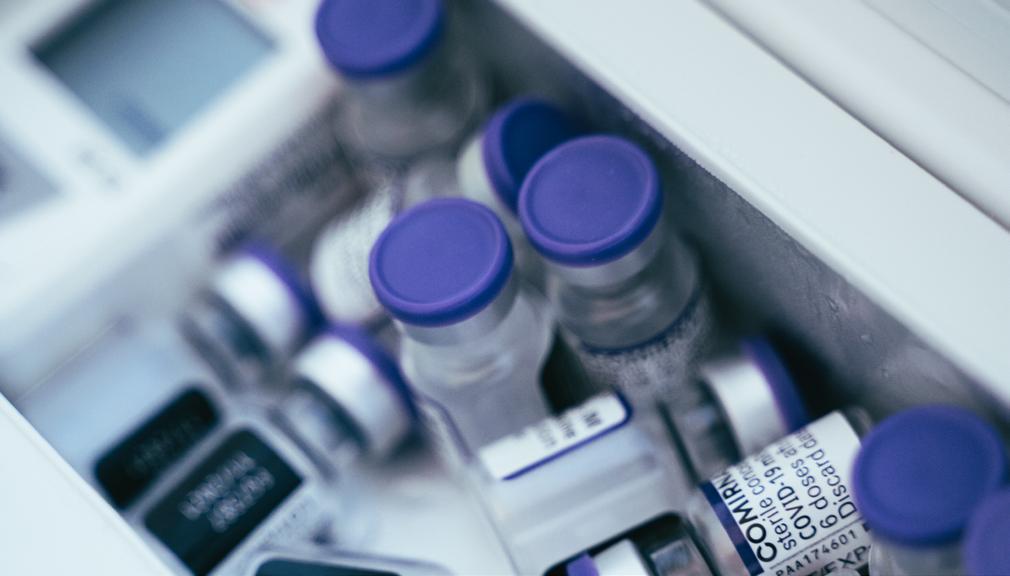
86 non-viable embryos and attempted to edit the genome which causes fatal blood disease, only some of them were successful due to off-target mutation. Also, CRISPR-Cas9 can affect off-target cells and alter the function of the gene which might cause genomic instability and hinder clinical procedures. Therefore, we cannot conclude that CRISPR-Cas9 is totally beneficial because several drawbacks and side effects exist.
References
L. Marpuri I. (2013). Grabbing hold of cells and tissues with zinc fingers. Genome.gov. Retrieved December 4, 2022, from https://www.genome.gov/grabbing-hold-of-cells-andtissues-with-zinc-fingers

Ashley, B., PM, 5:04, & Parthiban, P. (2020, October 7). Explained: What are CRISPR-Cas9 genetic scissors? The Federal. Retrieved December 4, 2022, from https://thefederal.com/science/explained-what-are-crisprcas9-genetic-scissors/ Asmamaw, M., & Zawdie, B. (2021, August 21). Mechanism and applications of CRISPR/cas-9-mediated genome editing. Biologics targets & therapy. Retrieved December 4, 2022, from https://www.ncbi.nlm.nih.gov/ pmc/articles/PMC8388126/#:~:text=The%20mechanism%20 of%20CRISPR%2FCas%2D9%20genome%20editing%20 can%20be,recognition%2C%20cleavage%2C%20and%20 repair.&text=The%20designed%20sgRNA%20directs%20 Cas,5%CA%B9crRNA%20complementary%20base%20 pair%20component.
Becker, S. (2021, May 28). Tale and talen genome editing technologies. Gene and Genome Editing. Retrieved December 4, 2022, from https:// www.sciencedirect.com/science/article/pii/ S2666388021000071#:~:text=In%202010%2C%20TALEN%20 were%20developed,of%20the%20general%20scientific%20 community.
Cas9 mechanism. CRISPRCas9. (n.d.). Retrieved December 4, 2022, from https://sites.tufts.edu/crispr/crispr-mechanism/ CRISPR clinical trials: A 2021 update. Innovative Genomics Institute (IGI). (2022, May 18). Retrieved December 4, 2022, from https://innovativegenomics.org/ news/crispr-clinical-trials-2021/ CRISPR guide. Addgene. (n.d.). Retrieved December 4, 2022, from https://www.addgene.org/guides/crispr/#:~:text=The%20 gRNA%20is%20a%20short,sequence%20present%20in%20 the%20gRNA.
Gene editing mechanism of CRISPR-Cas9. Wyss Institute. (2017, August 18). Retrieved December 4, 2022, from https://wyss.harvard.edu/media-post/geneediting-mechanism-of-crispr-cas9/
Klug, A. (2010). The discovery of zinc fingers and their applications in gene regulation ... Annual Reviews. Retrieved December 4, 2022, from https:// www.annualreviews.org/doi/10.1146/annurevbiochem-010909-095056
Ng, W. by D. (2022, August 26). A brief history of CRISPR-Cas9 genome-editing tools. Bitesize Bio. Retrieved December 4, 2022, from https://bitesizebio. com/47927/history-crispr/#:~:text=In%202012%2C%20 George%20Church%2C%20Jennifer,paste%E2%80%9D%20 tool%20to%20modify%20genomes.
Omodamilola, O. I. (n.d.). CRISPR technology advantages, limitations and future direction. Journal of Biomedical and Pharmaceutical Sciences. Retrieved December 4, 2022, from https://www.hilarispublisher.com/ open-access/crispr-technology-advantages-limitationsand-future-direction.pdf
panelRodolpheBarrangouEnvelope, A. links open overlay, RodolpheBarrangouEnvelope, Clustered regularly interspaced short palindromic repeats (CRISPR) and accompanying Cas proteins constitute the adaptive CRISPR–Cas immune system in bacteria and archaea. This DNA-encoded, Jinek, M., Sampson, T. R., Horvath, P., Bikard, D., Qi, L. S., Makarova, K. S., Barrangou, R., Makarova, K., Reeks, J., Sorek, R., Brouns, S. J., Marraffini, L. A., Hale, C. R., Garneau, J. E., Gasiunas, G., Levin, B. R., … Sander, J. D. (2015, January 6). The roles of CRISPR–Cas Systems in adaptive immunity and beyond. Current Opinion in Immunology. Retrieved December 4, 2022, from https://www.sciencedirect.com/ science/article/pii/S0952791514001563?via%3Dihubwebte am)
www-core (S. (2022, February 8). What is CRISPR-Cas9? @ yourgenome Science website. Retrieved December 4, 2022, from https://www.yourgenome.org/facts/ what-is-crispr-cas9/
SCIENCE
Photo by Mat Napo on Unsplash
Introduction to the CRISPR-Cas9
48
VOL.2 49
Photo by Misael Moreno on Unsplash
SPECTRUM
Voting Trees
by Akshay Agarwal
Elections. At first glance determining the winner of an election seems pretty straightforward: tally up each voter’s
graphs and trees, and finally, see how much of a better system we know, and how much better can it get.
For a smaller case, let’s assume that a particular election has ten candidates, with each of them numbered from one to ten, running for a single spot in a majority vote election. Now, let’s assume candidate one gets the majority of votes, barely surpassing candidate two by one vote. Out of the voters, there are two voters, voter A and voter B, whose ‘order’ of favourite candidates is

favourite candidate, and wallah, the one with the most votes is the ‘winner’. This, we soon will find out, is unfortunately the way most of our elections work: from student governments to club elections to presidential elections. However, assuming there’s a large election with hundreds of candidates, what if I told you the winner of such an election could potentially be less popular than more than half of the other candidates? That it deterministically doesn’t select the winner at all?
Rather, the winner of an election among hundreds of people cannot really be considered the winner at all. Today, we’ll begin by showing the issue of a normal election within a large group of candidates, then go on to explore the computer science data structures of
candidate four, candidate two, and then candidate one. Thus, in the election, they voted for candidate four (who didn’t get many votes), but if candidate four didn’t exist, they would both vote for candidate two who would then end up winning the election. Strange, right? Even though a candidate gets the most votes, they’re not necessarily the most popular candidate, they were just the most popular first choice of the voters. Therefore, mathematically speaking, the only deterministic way of determining the most popular candidate is by a direct comparison between two of them; candidate one vs candidate two, for instance. However, scaling a two-person voting system to a system with hundreds of candidates is difficult, and that’s what we’ll be trying to figure out. Let’s first begin by analyzing some intuitive ideas of such a system.
But first, as analyzing each voting system with words is cumbersome, all the voting systems we’ll be analyzing can be modeled as a directed graph, which is a data structure used in computer science. A directed graph consists of two parts: nodes and edges , where each node is a candidate, and each edge between nodes points to the “more popular” candidate of the two.
Mathematics
Voting Trees Photo by Element5 on Unsplash 50 SPECTRUM VOL.2 51
For instance, on the diagram to the left, the three green circles are the nodes, representing candidates one, two, and three. The edge between nodes one and three which points towards three, shows that candidate three is more popular than candidate one.

Personally, my first thought was to create a system where each pair of candidates goes against each other; if everyone goes against each other, the most popular candidate will inevitably be revealed. However, creating the directed graph for such a situation proves otherwise:
As is evident, even in this simple case with three candidates, each candidate beats one other candidate, and loses to another. So, from this graph, who’s the winner? Hard to tell right? This is what’s called a cyclic graph, as there’s a visible cycle. We don’t want to create a system where the graph will be cyclic, as determining the winner isn’t possible.
Now the second try, up till a few months ago, this was the best system mathematicians and computer scientists were able to create. Fischer, Procaccia, and Samorodnitsky worked on the Copeland Rule, which is essentially the simulation of an election as a ‘knockout tournament’. The graph of such a process is:
Ideally, the winner of an election would beat at least half the candidates, as that means they surpass at least half of the other candidates; this is significantly lower than that number. Unfortunately, nobody has been able to create an algorithm that achieves such amazing results; in fact, a group of three researchers recently made a model which made it such that the winner had to defeat square root of n of the other candidates. However, the scope of that article is beyond that of this paper, although the fundamental understanding of graphs is still required, so if you’re interested, feel free to look up Loh and Iglesias’ paper, referenced in the citations below.
This graph is one of a knockout tournament where the “1st round” has all four candidates, and each subsequent round removes half the candidates, until there eventually is only one left. Such a graph is a special case of a graph, known as a balanced binary tree, which means that each subsequent row you go down, doubles the number of children nodes (nodes below their “parent”). Such a voting tree certainly does yield a winner, as visible on the top node; however, notice the number of matches the winner needs to win: just two (in this example). In fact, mathematically, we can say that if there are n candidates, the winner will only have to beat log(n) (base 2) of the other candidates.


References
Iglesias, Jennifer, et al. “Computing with Voting Trees.” SIAM Journal on Discrete Mathematics, vol. 28, no. 2, Jan. 2014, pp. 673–684, 10.1137/130906726. Accessed 6 Nov. 2022.
F. Fischer., A. D. Procaccia, and A. Samorodnitsky, A new perspective on implementation by voting trees, Random Structures and Algorithms 39 (2011), 59–82.
Even if you’re not going to be the one who spends years of their life on improving the voting tree, I hope this article gives you a better perspective on graphs in computer science, how to efficiently improve an algorithm, and the way we can solve practically any real-life situation with the power of computer science. In the future, whenever you see any sort of system, whether that be how school bus paths are decided or how Youtube searches work, I hope this article gives you the concept of how to analytically analyze such algorithms, and potentially improve on them. I’ll hopefully be able to open the newspaper one day and see you listed for analytically improving an important algorithm. SPECTRUM VOL.2 53
N. Miller, A new solution set for tournaments and majority voting: further graph theoretical approaches to the theory of voting. Am. J. Pol. Sci. 24 (1980), 68-96. Voting Trees MATHEMATICS 52
The Applications of Artificial Proteins and What It Means for the Future of Medicine
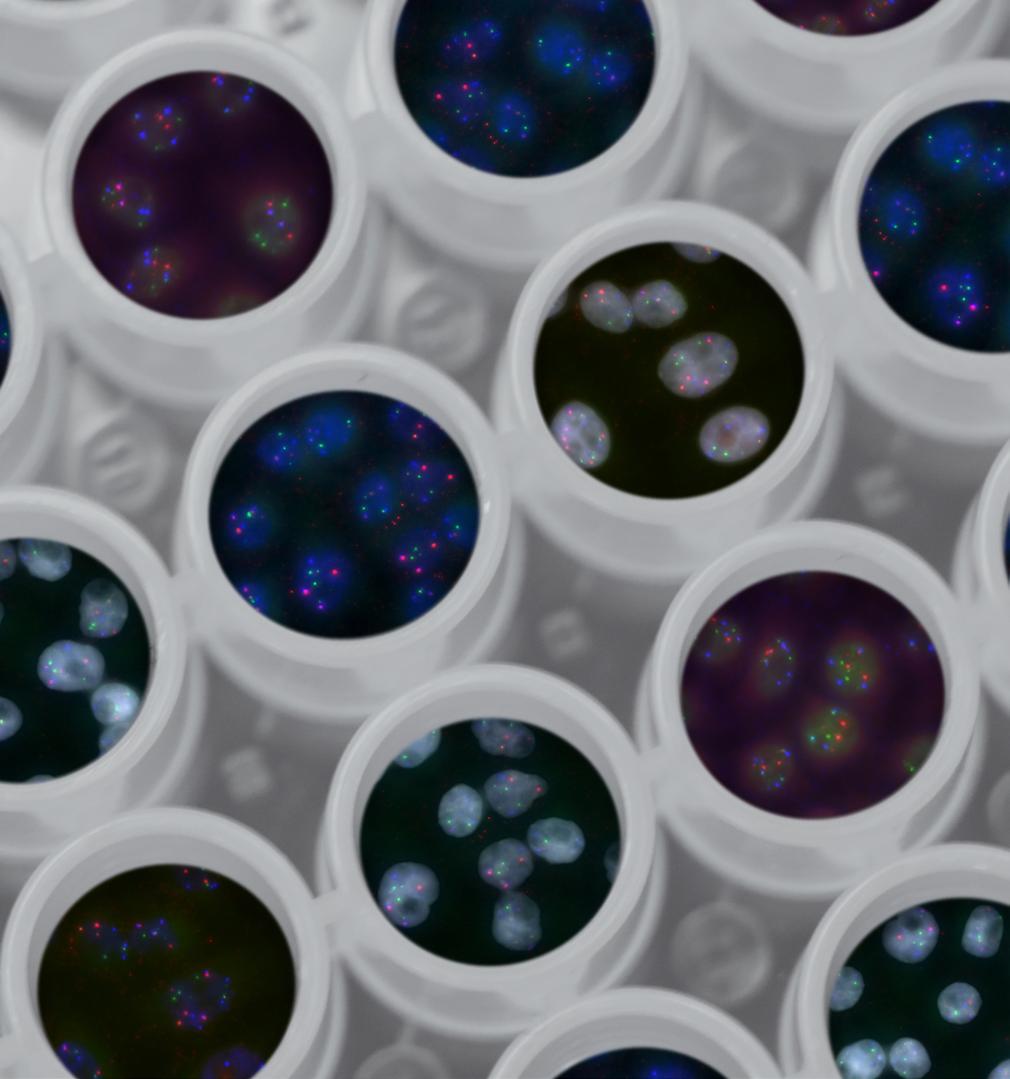 by Vyjayanti Vasudevan
by Vyjayanti Vasudevan
Gerardus Johannes Mulder, a 19th-century chemist, was the first to have coined the term ‘protein’, following his observation concerning the differences in the molecular structures of egg albumin, casein, and other animal structures compared to molecules with
similar composition. It was found after years of thorough research conducted by Mulder and his students that showed that the differences between these molecules were due to the presence of singlestranded macromolecules now known as proteins.
noted in Mulder’s 1838 paper,
(Mulder, 1838)
Although Mulder’s claim may now be looked upon as radical, he surely was onto something. Proteins are made up of a basic structural unit of amino acids, and help regulate and catalyze many of the biochemical processes that occur within our bodies each and every day. Additionally, the study of the chemical and molecular structure of proteins is currently of utmost importance when it comes to replicating proteins to help with the effectiveness of vaccines; understanding the threats of biowarfare; and animal drugs to promote breeding, carcass composition, etc.

So now that we know what an important role protein plays in our normal bodily functions, how might we apply our knowledge of proteins in the real world? Diabetes, one of the leading causes of death around the world, is caused by complications in inadequate insulin production or function. Insulin, a crucial
hormone in the body that regulates glucose levels in the bloodstream, is made up of a complex string of amino acids. Problems with insulin whether it be with its function or production are therefore rooted in the hormone’s early stages of
 Photo by Mika Baumeister on Unsplash
Photo by Mika Baumeister on Unsplash
SCIENCE
As
“The plant-feeding animals are thus, considered from this point of view, not different from the flesh-eating”
The Applications of Artificial Proteins and What It Means for the Future of Medicine
Photo by National Cancer Institute on Unsplash
55 54 SPECTRUM VOL.2
production during protein synthesis. An ongoing region of interest in this field is “cell-free protein synthesis”, in which scientists are working towards producing an artificial protein from scratch. The application of the creation of synthetic proteins through such cellfree protein synthesis could revolutionize the treatments for diabetes by creating a more effective synthetic insulin.
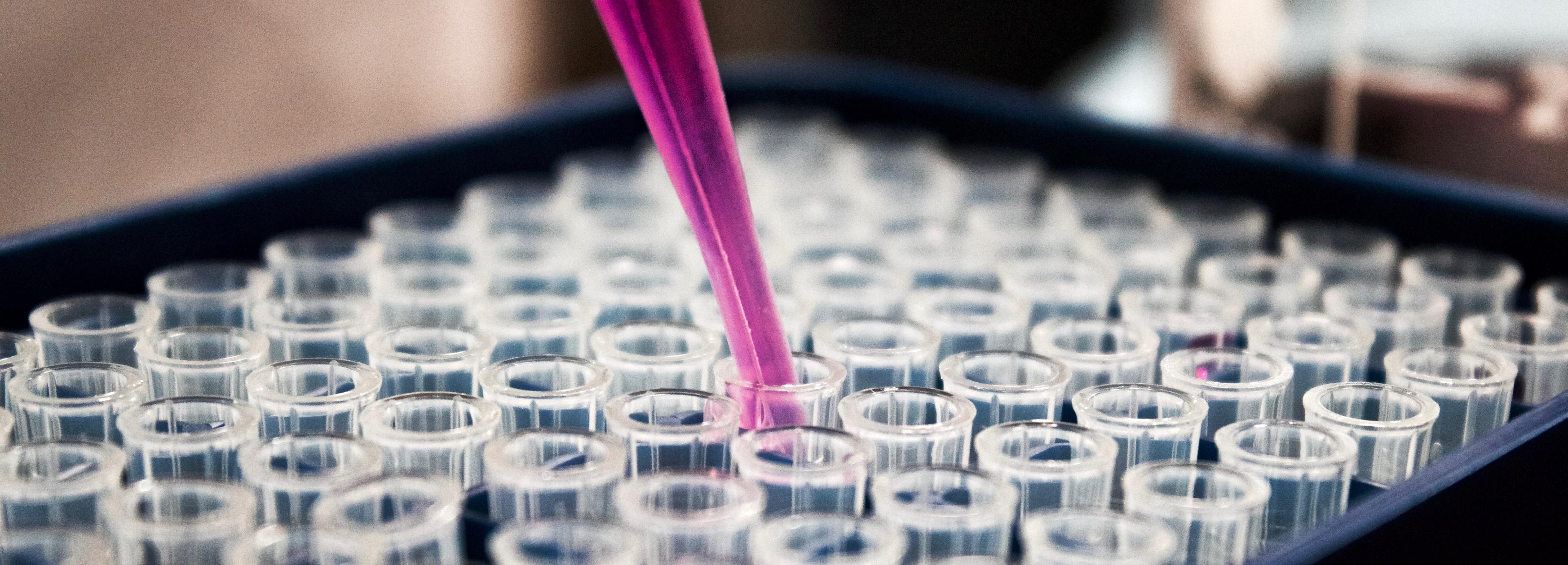
Moreover, this field of study is becoming more relevant with ongoing epidemics affecting millions worldwide; whether it be Ebola, Yellow Fever, or smallpox, research into synthetic proteins plays a vital role in the creation of RBDs to boost the effectiveness of vaccines and the overall immunity. The RBD or receptorbinding domain of a virus is located on the protein’s surface which is able to bind to the receptor on a cell which
then internalizes the receptor. In many cases, like the coronavirus, the immune system is unable to recognize the said virus’ RBD and thereby doesn’t produce an antibody for that RBD in time. On the other hand, artificial proteins that contain the same RBD spike without the infectious virus may be able to help the immune system ward off the virus in the future through exposure. To look at the idea of developing just a feature of the protein--- the RBD--- scientists study immunogens, an abstract term for any structure that initiates an immune response, and how they might mimic its functional properties. More specifically, this emerging field aims to replicate a non-infectious viral vector, the RBD, to enhance immunogenicity, and the immune response to the viral vector. However, the development of artificial
proteins poses risks that must be carefully considered before moving ahead with such research. The ability to replicate synthetic proteins also comes with the risk of harnessing power at the most essential level.
We’ve seen bioterrorism in the past, from the chemical weapons utilized by the Japanese in WW2 and the rumored Agent Orange rumored to have been weaponized against the Vietnamese in the Vietnam War. With that being said, replicating biology is a herculean task with immense challenges. It is likely that any feature of the human body will never be able to be replicated in a lab to its same energy efficiency and adaptivity. Moving forward, we therefore must place more emphasis on studying the human body and to better stimulate fields such as chemical protein synthesis to understand the limitations of where we should travel with our understanding of the natural world with humanity's shared goal of saving lives.
References:
Greg Guyer, C., & Miller, M. (1994). Human Food Safety Evaluation of Repartitioning Agents. Low-Fat Meats, 53-63. doi: 10.1016/b978-0-08-091853-2.50009-3
Jacobsen, R. (2022). Artificial Proteins Never Seen in the Natural World Are Becoming New COVID Vaccines and Medicines. Retrieved 26 October 2022, from https://www. scientificamerican.com/article/artificial-proteins-neverseen-in-the-natural-world-are-becoming-new-covidvaccines-and-medicines/

New technology enables fast protein synthesis. (2020). Retrieved 26 October 2022, from https://news.mit.edu/2020/ faster-protein-synthesis-0528
Machine Learning Builds Artificial Proteins That Rival Nature’s Own. (2022). Retrieved 26 October 2022, from https://www.technologynetworks.com/proteomics/news/ machine-learning-builds-artificial-proteins-that-rivalnatures-own-337900
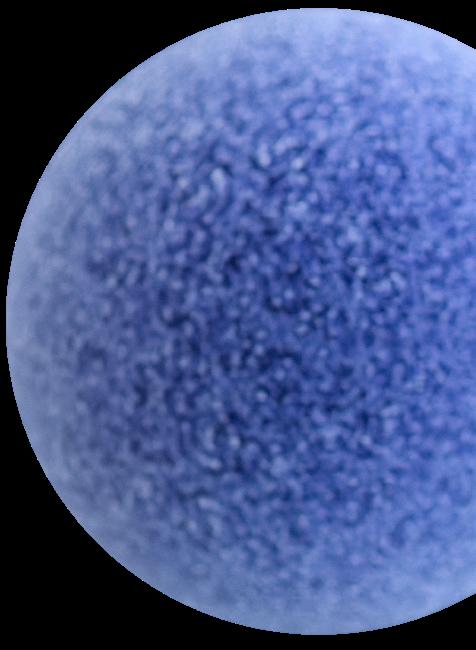
SCIENCE
Unrestrained bio development of new pathogens using infectious viral vectors to intoxicate living beings is a serious threat that could lend itself to a new kind of warfare----bioterrorism.
Photo by Louis Reed on Unsplash
56 SPECTRUM VOL.2 57
The Applications of Artificial Proteins and What It Means for the Future Of Medicine
Singing Black Holes
by Alanna Hattori
the intricate and compelling details about the basics of the black hole, but how do these black holes sing?
S
pace, a mysterious and elusive part of our world, one filled with extremely powerful objects such as celestial meteor showers and asteroids, but by far the most powerful force in the universe is the black hole, with its ability to consume anything that dares to come too close, including stars, moons, and even whole planets. A couple of years ago, one of the most interesting things that NASA managed to capture was a clip of a black hole... singing.
To begin, what exactly is a black hole and what do they do? Well, "a black hole is a place in space where gravity pulls so much that even light cannot get out. The gravity is so strong because matter has been squeezed into such a tiny space"(Wild). This shows how powerful black holes can be; they can just consume anything and everything around them, and since black holes are created when a star reaches the end of its life, the black holes still retain some of the star's
powerful mass. These black holes then grow in size as they consume more and more matter. When the black hole increases in size, the point horizon of the black hole also increases in size, and the point horizon is the ultimate point of no return (Haynes). This means that as the black hole expands, things like matter, gas, or dust completely vanish when they enter the black hole due to the expanding point horizon. Overall, we can see all of
Well, in 2003, NASA released a clip of a black hole in the Perseus galaxy cluster emitting a strange, high-pitched tune. This clip baffled astronomers and people all around the world; not only were bodies in space making noise, which is strange enough, but most had been led to believe that noises could not be made in space. While sound waves can be heard on earth because we have mediums for the sound waves to move through, for example, air, where air molecules can vibrate and bump into each other, creating a chain reaction that transports the sound waves, in space there is no medium for the sound waves to travel through air or water (Scientific American). However the black hole in the Perseus galaxy cluster is not like most other black holes; it also happens to be in a vast cloud of gas, providing a mode of transportation for the sound waves (Roberts), but how does the black hole create the sound?
Jonathan Blazek, a professor at Northeastern University with expertise in astrophysics and galaxy clusters, tries to explain this phenomenon. He says that due to all the gas around the black hole, it will start spitting out this energy in a sporadic way, similar to a speaker creating some frequency of sound. This means that the gasses in the hole are pushing against each other to create a physical sound wave (Blazek). This shows us how exactly the sound was able to be produced by the black hole in the first place, but the sound itself was too low for humans to hear, so it had to be edited up 57–58 octaves for humans to even hear the noise (Roberts). This then shows us exactly how this sound was able to be produced.
In conclusion, black holes have once again baffled scientists with the intricacies of their many capabilities, but overall, this is one step closer for researchers and astronauts to truly understand the structure and skills of black holes.

References
American, S. (2007). Strange but True: Black Holes Sing. Retrieved 7 November 2022, from https://www. scientificamerican.com/article/strange-but-true-blackholes-sing/
Hear the Weird Sounds of a Black Hole Singing. (2022). Retrieved 7 November 2022, from https://www.nytimes. com/2022/05/07/science/space/astronomy-black-holesound.html

How do black holes form?. (2022). Retrieved 7 November 2022, from https://astronomy.com/news/2020/02/how-doblack-holes-form
NASA releases eerie ‘singing’ from a black hole and it’s straight out of a horror movie. Retrieved 7 November 2022, from https://www.classicfm.com/music-news/videos/nasablack-hole-singing-sound/
New NASA Black Hole Sonifications with a Remix. (2022). Retrieved 7 November 2022, from https://www.nasa.gov/ mission_pages/chandra/news/new-nasa-black-holesonifications-with-a-remix.html
SCIENCE
Photo by Unsplash
Singing Black Holes 59 58 VOL.2 SPECTRUM
Genetically Modified Foods
by Utsa Chaturvedi
World hunger has been on the rise for decades. According to the World Food Programme, the foodassisted branch of the United Nations, climate change, conflict, and the COVID-19 pandemic caused the number of undernourished people to grow by as many as 150 million in the last three years.
Moreover, according to estimates by the United Nations Food and Agriculture Organization, the world will have to grow 70 percent more food by 2050 to keep up with population growth.
Climate change will make large portions of the world’s arable land (land that is suitable for growing crops) more difficult to farm.

derived from organisms whose genetic material, or DNA, has been altered in a way that does not occur naturally; for instance, through the introduction of a gene from a different organism. Currently available GM foods stem mostly from plants, but it is likely that foods derived from genetically modified microorganisms or animals will be introduced in the future. Today, GM foods are a highly debated topic among the scientific community.
With issues like climate change and world hunger constantly worsening, it is important for us to find ways to either entirely change our consumption habits, or find new methods of food production. One such potential solution is genetically modified foods (GM foods), though it faces controversy. GM foods are foods
GM foods have many benefits, as they have been specifically developed to combat issues with food production. For instance, genetic engineering can improve crop yield, and crops can even be engineered to be more nutritious, providing critical vitamins to populations that struggle to get specific nutrients needed for healthy living. Furthermore, GM foods are also useful in controlling the occurrence of certain diseases, and allergy-causing properties in these foods are also eliminated due to modifying their DNA system.

SCIENCE
Photo by Ami Kkalhor on Unsplash
Genetically Modified Foods
61 60 SPECTRUM VOL.2
Photo by Bradyn Shock on Unsplash
David Zilberman, a U.C. Berkeley agricultural and environmental economist, says that the use of genetically modified crops


“has increased farmer safety by allowing them to use less pesticide”, and has “raised the output of corn, cotton and soy by 20 to 30 percent, allowing some people to survive who would not have without it.”
He believes that adopting GM foods widely would lead to lower food prices, and fewer deaths due to hunger. Furthermore, the safety of GM foods has also been proven countless times - the European Commission, the administrative body of the E.U., has funded 130 research projects on the safety of GM crops, and none of those studies found any special risks from GM crops. The American Association for the Advancement of Science, the American Medical Association and the National Academy of Sciences have all backed GM crops. Hence, GM foods provide a variety of benefits if chosen to be utilized.
However, despite the many supportive stances on genetically modified food, there are many who believe that the risks outweigh the benefits. Genetically engineering foods is a relatively new practice, which means the long-term effects on safety are not yet clear. More generally, public perception of GM foods is plagued by concerns of safety, from the potential for allergic response to the possible transfer of foreign DNA to non-GM plants in the area. None of these concerns are backed by evidence, but they still persist. Throughout Asia, governments have yet to approve most GM crops, and in Africa, several nations have refused to import GM foods in spite of their lower costs. David Williams, a cellular biologist who specializes in vision, says, “A lot of naive science has been involved in pushing this technology…Inserted genes can be transformed by several different means, and it can happen generations later.”
It is important to take action towards understanding the effects of genetically modified foods at a deeper level, and to change people’s perceptions towards them. Scientists, governments, and consumers will have to work together to ensure a future where humans can benefit from genetically modified foods’ significant benefits.
References
Are genetically modified crops the answer to world hunger? National Geographic Society. (n.d.). Retrieved October 30, 2022, from https://education.nationalgeographic.org/ resource/are-genetically-modified-crops-answer-worldhunger
Bawa, A. S., & Anilakumar, K. R. (2012). Genetically Modified Foods: Safety, risks and public concerns—a review. Journal of Food Science and Technology, 50(6), 1035–1046. https:// doi.org/10.1007/s13197-012-0899-1
Freedman, D. H. (2013, September 1). The truth about genetically modified food. Scientific American. Retrieved October 30, 2022, from https://www.scientificamerican.com/ article/the-truth-about-genetically-modified-food/
A Global Food Crisis: World Food Programme. UN World Food Programme. (n.d.). Retrieved October 30, 2022, from https:// www.wfp.org/global-hunger-crisis
Is it safe to eat GM crops? Royal Society. (n.d.). Retrieved October 30, 2022, from https://royalsociety.org/topicspolicy/projects/gm-plants/is-it-safe-to-eat-gm-crops/
MediLexicon International. (n.d.). Pros and cons of GMO Foods: Health and Environment. Medical News Today. Retrieved October 30, 2022, from https://www. medicalnewstoday.com/articles/324576#cons
Pew Research Center. (2020, August 27). 3. public opinion about genetically modified foods and trust in scientists connected with these foods. Pew Research Center Science & Society. Retrieved October 30, 2022, from https://www. pewresearch.org/science/2016/12/01/public-opinion-aboutgenetically-modified-foods-and-trust-in-scientistsconnected-with-these-foods/
World Health Organization. (n.d.). Food, genetically modified. World Health Organization. Retrieved October 30, 2022, from https://www.who.int/health-topics/food-geneticallymodified#tab=tab_
SCIENCE
Genetically Modified Foods
Though genetically modified foods are not the cure-all for world hunger - the path to eradicating global hunger is more complex than only addressing food quantity or quality - they can certainly be one part of the solution to addressing it.
62 SPECTRUM VOL.2 63
Photo by Yi Zhu on Unsplash

TECHNOLOGY & ENGINEERING Quantum Computing: The Future of Technology Nikita Chanda Artificial Intelligence: The Next Step in Automation Daniel Ng Making Computers More Like Our Brains Lauren Lim Technology to Combat Food Waste Yil-lin Jeon The Imitation Game Chanyeong Park 66 70 82 76 78
The Future of Technology
by Nikita Chanda
I n 1899, an intriguing science problem caught German physicist Max Planck's eye. Because of the laws of thermodynamics, a “black body,” something that perfectly absorbs all frequencies of light, should emit all the frequencies of light it absorbs equally–right? Wrong; the predicted distribution of energy radiated was not reality.¹ Planck decided to address this problem from a viewpoint most would have never considered. What if energy wasn’t just a continuous wave? He proposed that energy also came in discrete packets called “quanta”.¹ Although not accepted then, this was the basis of quantum mechanics.¹ Groundbreaking work from famous scientists like Albert Einstein and Niels Bohr wouldn’t have been possible without this discovery. Quantum mechanics emerged as a new subfield of modern physics that helped scientists view the universe in a new light.
How is this particularly relevant, one may ask? Well, without quantum theory, the chips that run our computers would not exist. Now, what if there was a quantum nature to the computer chip itself? This is the basis of quantum computing.
 TECHNOLOGY
Quantum Computing: The Future of Technology
Photo by Manuel on Unsplash
TECHNOLOGY
Quantum Computing: The Future of Technology
Photo by Manuel on Unsplash
66 SPECTRUM VOL.2 67
Quantum computers implement the principles of quantum mechanics to solve problems too advanced for classical computers, computers that perform binary computing, to calculate. You may have heard of the famous Schrödinger’s Cat thought experiment: a cat and radioactive material– which could decay at any time, or never– are placed into a box, concealing them from any person’s view.² Without opening the box, Austrian physicist Erwin Schrödinger stated, the cat would be considered both dead and alive since its fate is linked to an event with an unknowable outcome.²
In quantum mechanics, this paradox is known as quantum superposition; every entity is in a superposition of two different properties– a particle and a wave. This is known as wave-particle duality. Similarly, while a regular computer uses bits that can be set to 0 or 1, quantum computers use “quantum bits,” or qubits, that can be set to 0, 1, or both 0 and 1 at the same time. This way, it can represent every potential answer as an abstract quantum wave, where the waves will interfere and cancel each other out inside the core of the machine, revealing the correct solution.³
Because of this, quantum computers can execute tasks exponentially faster than classical computers. Exponentially faster. One may call this a superiority over conventional machinery, or a “quantum advantage”.⁴ To quantify the weight of this supremacy: a quantum computer can do what would take the best supercomputer around 9000 years.⁴ As is usually the case, with great power comes great responsibility. Granted with
the exceptional ability to decode publickey encryption schemes, quantum computers can do things influential to the development of science and technology today– but are already a looming threat to society.

In theory, these computers can “exploit quantum rules to provide ultra-secure communication across channels” that are “immune to hacking”.⁵ However, this comes hand-in-hand with the biggest concern regarding the development of the quantum computer: hacking. Due to the genuine possibility of attack by a quantum computer, cryptographers and mathematicians are already working on new algorithms to prevent quantum hacking.3 This May 2022, the White House created a new national security memorandum, stating that despite quantum computers’ “potential to drive innovations across the American economy,” it is also a great challenge to the United States’ national and economic security.⁶ For instance, in addition to its threat to the public-
key encryption system, it also has the potential to “jeopardize civilian and military communications, undermine supervisory and control systems for critical infrastructure, and defeat security protocols for most Internet-based financial transactions”.⁶
The bottom line: quantum computing is astronomically more powerful than classical computing, opening up a wide array of possibilities for completing complex tasks to the world’s benefit. New methods of climate prediction, for example, can be revolutionary because of the quantum computer's ability to “analyze all available data at once,” allowing us to prepare for dangerous weather much in advance as well as anticipate how the environment is changing over long periods of time by developing better climate models.⁷ While there may be dangers to quantum computing, advancement in technology is inevitable, and it is up to our generation to make sure the future of technology isn’t in the wrong hands.
References
1 “A Science Odyssey: People and Discoveries: Planck Discovers the Quantum Nature of Energy.” PBS, Public Broadcasting Service, https://www.pbs.org/wgbh/aso/ databank/entries/dp0 0qu.html#:~:text=Planck%20 found%20that%20the%20energy,higher%20energy%20 will%20be%20radiated.
2 Howgego, Joshua. “Schrödinger's Cat.” New Scientist, https://www.newscientist.com/definition/ schrodingers-cat/.
3 Cho, Adrian. “Worried That Quantum Computers Will Supercharge Hacking, White House Calls for Encryption Shift.” Science, 5 May 2022, https://www.science.org/ content/article/worried- quantum-computers-willsupercharge-hacking-white-house-calls-encryption-shift.
4 Wilkins, Alex. “Quantum Computers Proved to Have 'Quantum Advantage' on Some Tasks.” New Scientist, New Scientist, 15 June 2022, https://www.newscientist.com/ article/2323540- quantum-computers-proved-to-havequantum-advantage-on-some-tasks/.
5 Institute, Foundational Questions. “New Connection Discovered between Two Weird Quantum Phenomena –Superposition and Entanglement.” SciTechDaily, 3 May 2022, https://scitechdaily. com/new-connection-discoveredbetween-two-weird-quantum-phenomena-superpositionand-entanglement/.
6 “National Security Memorandum on Promoting United States Leadership in Quantum Computing While Mitigating Risks to Vulnerable Cryptographic Systems.” The White House, The United States Government, 4 May 2022, https://www.whitehouse.gov/briefing-room/statementsreleases/2022/05/04/national-security-memorandumon-promoting-united-states-leadership-in-quantumcomputing-while-mitigating-risks-to-vulnerablecryptographic-systems/.
7 Taylor-Smith, Kerry. “Using Quantum Computing to Tell the Weather.” AZoQuantum.com, 19 Dec. 2018, https://www. azoquantum.com/Article.aspx?ArticleID=98.
TECHNOLOGY Quantum Computing: The Future of Technology
68 SPECTRUM VOL.2 69
Photo by Rene Bohmer on Unsplash
Artificial Intelligence: The Next Step in Automation
by Daniel Ng
Elon Musk
Introduction
Throughout history, we have seen how technology serves as the vessel carrying the ambitions for automation into reality. As a natural consequence of advancing civilizations, the growth in knowledge and accessibility to resources open a new gateway of opportunities for developing technology. One of the general goals that technology seems to be embedded in is convenience or more specifically automation. For example, before airplanes, cars, and trains, the vast majority of humanity traveled by foot or on horse. This tedious process to get from point A to point B often took days or even weeks.
The invention of vehicles has allowed humans to travel long distances without stopping while limiting human input (effort). Artificial intelligence can make the process of getting from point A to B with even less effort through self-driving. This is only one of the many applications of AI that humans have developed throughout the past decade. It is only a matter of time before artificial intelligence
will consume the transportation, manufacturing, healthcare, education, media, and customer service industries. Developing an understanding of AI may not only open up a world of interests and
Concepts + Forms

There are four definitions of what an AI can do: (1) thinking humanly, thinking rationally, acting humanly, and acting rationally. Emerging from these definitions is the categorization of AI.

“AI will be the best or worst thing ever for humanity.”
TECHNOLOGY
Photo by Deepmind on Unsplash
Artificial Intelligence: The Next Step in Automation
71 70 SPECTRUM VOL.2
Photo by Deepmind on Unsplash
Artificial General Intelligence (AGI) is a category of AI used for a diverse range of tasks. Its objective is extensive which is why it can improve itself by learning, similar to the capabilities of the human brain.
Artificial Super Intelligence (ASI) is the most superlative form out of the three, hence the label “super”. This type of AI is more sophisticated and advanced than any other as it can contemplate abstract concepts that transcend human capacity.
The three forms of AI listed above are defined similarly but are labeled differently across the world. Another definition for the terms above proposed by Michigan State University’s Arend Hintze in similar order is reactive machines, limited memory, and theory of mind.Now
that we know the different forms of AI, it begs a few questions about the actual creation of AI.
Programming Languages
AI is programmed on the basis of five major programming languages: C++, Java, Lisp, Python, and Prolog. C++ is loaded with many library functions and tools in programming that could allow AI systems to thrive. Java is a highly versatile language that can be implemented and traversed into other platforms. Lisp is efficient and fast as it has an automatic memory manager. Python is faster than Java or C++ as it not only has a variety of tools and libraries that assist you in coding but a testing ability for algorithms. Depending on the language
used, breadth of complexity, and purpose of the AI, proficiency in various other mathematics-related subjects such as multi-variable calculus, matrix algebra, and statistics are required.
(4)-Natural language processing is the ability of a machine to comprehend, analyze and even reproduce human speech
(5)-Deep learning is a superior subset of machine learning that allows AI to process substantial amounts of information and identify patterns, allowing functions such as speech recognition in AI.
The application of these properties allows AI to replicate human processes such as learning, decision-making, interpreting, analyzing, and speaking more efficiently. This opens a highway of possibilities for technology. An example out of many is being able to use robots to work in scenarios that would otherwise be dangerous for humans.


Subfields: AI Tech
When it comes to the characteristics of AI that make it so unique and powerful, the following five are what give AI its properties.

(1)-Neural networks that are interconnected allow machines to learn by processing data from external sources
(2)-Machine learning utilizes various neural networks and additional information to learn from without being programmed to make conclusions
(3)-Cognitive computing allows machines to simulate human-like processes by interpreting input such as images and diction
Photo by Deepmind on Unsplash
Photo by Rock n Roll Monkey on Unsplash
Photo by Thisisengineering Raeng on Unsplash
TECHNOLOGY
73 72 VOL.2 SPECTRUM
Artificial Intelligence: The Next Step in Automation
What can it do?
What it can’t do … yet.
Now that we get the gist of how AI works, you might be wondering what can they actually do, or what the limitations of such a powerful system are.
Can: Self-driving, voice assistant, digital marketing, produce digital art, writing assistant, etc.
Can’t: Generate long-form texts, compose songs, use common sense, adapt/ improvise, etc.
Ethical implications
Unemployment - already a large issue at hand, AI might contribute to making it worse (except for more jobs for programmers)
Inequality - the wealth generated by machines, how to distribute
Humanity - the potential effects of replicating or imitating human behavior and interaction with human beings
Bias - some argue that although AI itself can be objective, the programmer has biases that can be programmed into AI
Security - powerful technology can be used for criminal purposes as well Singularity - how do we stay in control
Robot rights - if robots become selfconscious or acquire other basic characteristics of humans, should they also have rights like humans? (they might have feelings and emotions)
Conclusion
Artificial intelligence algorithms, unlike passive machines that are only capable of predetermined or mechanical responses, are able to utilize real-time data to make well-considered decisions, similar to how a human brain detects patterns to learn and make decisions. However, artificial intelligence is not limited by cognitive capacity, ingrained cognitive biases, the ability to process complex information, and numerous other factors restricted by human biology. The potential of artificial intelligence to benefit humanity is revolutionary. Learning a bit about it or possibly viewing it as a career to pursue might be something to consider.
References
Schroer, A. (2022, September 19). What Is Artificial Intelligence (AI)? How Does AI Work? | Built In. Builtin.com. https://builtin. com/artificial-intelligence
admin. (2019, December 17). How Does AI Work. Digital Silk. https://www.digitalsilk.com/how-does-ai-work#ArtificialIntelligence-4-Concepts-of-Artificial-Intelligence


How Does AI Actually Work? (2021, August 9). Colorado State University Global. https://csuglobal.edu/blog/how-does-aiactually-work
Artificial Intelligence (AI): What it is and why it matters. (2022). Sas.com. https://www.sas.com/en_us/insights/analytics/ what-is-artificial-intelligence.html#technical
Kumari, R. (2021). 7 Differences between Artificial Intelligence and Human Intelligence Analytics Steps. AnalyticsSteps. https://www.analyticssteps.com/blogs/7-differencesartificial-intelligence-ai-human-intelligence
phrasee. (2018, November 27). 6 things AI can do, and 5 things it can’t (yet) - Phrasee. Phrasee. https://phrasee.co/ blog/6-things-ai-can-do-and-5-things-it-cant-yet/
Bossmann, J. (2016, October 21). Top 9 ethical issues in artificial intelligence. World Economic Forum. https://www. weforum.org/agenda/2016/10/top-10-ethical-issues-inartificial-intelligence/

TECHNOLOGY
74 SPECTRUM VOL.2 75
Artificial Intelligence: The Next Step in Automation
by Yil-lin Jeon
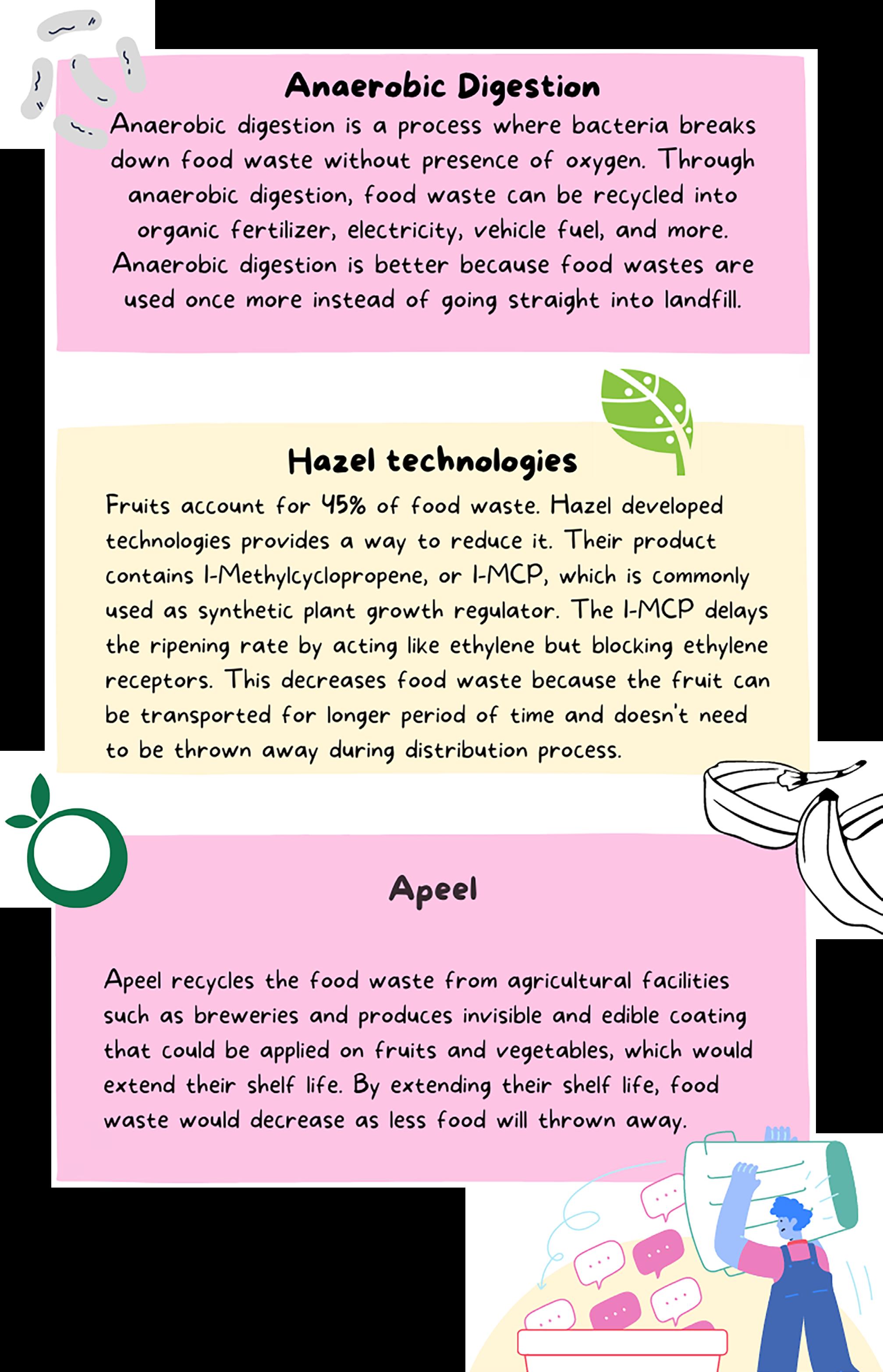



VOL. 2 Technology to Combat Food Waste TECHNOLOGY 76 SPECTRUM VOL.2 77
The Imitation Game
by Chanyeong Park
We live in a modern world where Artificial Intelligence(AI) permeates our daily lives. Siri, Instagram video filters, and even your lovely Netflix recommendation systems are used in our lives. Generally, when people think about AI, they believe it can actually “think.” But do they really? Let’s figure that out.
To begin with, we should start with definitions of the meaning of the terms ‘machine’ and ‘think’.The definitions might be framed so as to reflect as far as possible the normal use of the words, but this attitude is problematic. Think about it, if the meaning of the words ‘machine’ and ‘think’ are to be found by examining how they are commonly used, then it is no more than a statistical survey on the frequency of the words, which is absurd.
To address this issue, Alan Turing, a highly influential figure in the field of theoretical Computer Science, came up with a test to examine a machine's ability to exhibit intelligent behavior equivalent to humans: The Turing Test, A.K.A “The Imitation Game.”

ENGINEERING
The Imitation Game
Photo by Andrea De Santis on Unsplash
78 SPECTRUM VOL.2 79
Imagine a simple party game involving three players. Player A is a man, player B is a woman, and player C (who plays the role of the interrogator) is of either sex. In the imitation game, player C cannot see either player A or player B and can communicate with them only through written notes. By asking questions of player A and player B, player C tries to determine which of the two is the man and which is the woman. Player A's role is to trick the interrogator into making the wrong decision, while player B attempts to assist the interrogator in making the right one.

intelligence cannot be answered. The Turing test, though imperfect, can at least provide something measurable, a novel, yet pragmatic attempt to answer a difficult philosophical question.
development in AI, Turing allowed a more tangible way to think about what “thinking” really means, which has been foundational for the initial progress in AI algorithms.
Turing then asks: "What will happen when a machine takes part in A in this game? Will the interrogator decide wrongly as often when the game is played like this as he does when the game is played between a man and a woman?" These questions are essentially equivalent to the question in the introduction,
Visual image of the Turing test
The power and appeal of the Turing test come from its simplicity. The philosophy of mind, psychology, and modern neuroscience has been unable to provide definitions of "intelligence" and "thinking" that are sufficiently precise and general to be applied to machines. Without such definitions, the central questions of the philosophy of artificial

Turing did not explicitly state that the Turing test could be used as a measure of "intelligence," or any other human quality. He wanted to provide a clear and understandable alternative to the word "think," which he could then use to reply to criticisms of the possibility of "thinking machines" and to excel in the research on “thinkable” machines. Numerous experts in the field, including cognitive scientist Gary Marcus, insist that the Turing test only shows how easy it is to fool humans and is not an indication of machine intelligence.
Although many people regard the Turing Test as irrelevant to the current
References: Turing, A. M. (1950, October). COMPUTING MACHINERY AND INTELLIGENCE. Academic.oup.com. Retrieed November 19, 2022, from https://academic.oup.com/mind/article/ LIX/236/433/986238
The Imitation Game ENGINEERING 80 SPECTRUM VOL.2 81
Making Computers More Like Our Brains
 by Lauren Lim
Photo by Lorenzo Herrera on Unsplash
by Lauren Lim
Photo by Lorenzo Herrera on Unsplash
The human brain is a delicate lump of neural tissue that lives in our heads. This neural tissue, however, keeps numerous vital and intricate body systems running, allows us to interact with the outside world, and gives us the capacity for complex thoughts and emotions. Now, researchers are trying to approach computing in a similar way by using a combination of electrical and chemical signals like neurons do. Far superior to current computational technology, the brain is energy efficient, has rapid processing speed, and can potentially store unlimited information. Neuromorphic computing is based on enhancing computers by mimicking the brain, which could lead to developments in AI technology and computers that
can connect and interact directly with the brain.
As the word “semiconductor” might suggest, the main materials used in semiconductor chips are pure metalloids, like silicon or germanium, which are poorer conductors of heat and electricity than metals (Segal, 2022). The properties of these elements allow developers to control the flow of energy through the material. Since their invention in the mid-20th century, semiconductor chips have become the basis of how modern electronics operate, but researchers are approaching the limits of advancement in semiconductor technology. Semiconductor chips are unable to meet the high demands of modern-day computing challenges, especially with the focus on AI development (Gumyusenge et al., 2021). Despite rapid progress in

ENGINEERING Making Computers More Like Our Brains
83 82 SPECTRUM VOL.2
recent decades, AI is still leagues away from reaching the level of complexity and energy efficiency that animal brains have. In addition to the limits of semiconductor chips, due to the way conventional computers operate, information has to be transported between locations for processing and calculation, which limits the computer’s efficiency (Rand, 2021). This has led researchers to develop neuromorphic computer chips to mimic the structure of the brain.

The nervous system is formed of about 85 to 100 billion neurons that are in constant communication with one another (Seladi-Schulman, 2019).
Neurons connect and transmit signals at sites called synapses. When a neuron fires, an electrical impulse travels along the neuron’s axon. This electrical signal causes neurotransmitters, or chemical messengers, to be released into the gap between one neuron’s axon and another neuron’s dendrites. When they bind to dendrites, neurotransmitters either increase or decrease the electrical potential of the receiving neuron firing. Unlike a traditional computer, which separates memory and calculation, each neuron individually processes and stores its electrical state, making it more energyefficient and memory dense.
“When you have classical computer memory, it’s either a zero or a one. We make a memory that could be any value between zero and one. So you can tune it in an analog fashion,” said Alberto Salleo, a materials scientist at Stanford University (Kleiner, 2022).
Computers work algorithmically and rigidly with binary. On the other hand, the nervous system is a non-sequential network, so it can operate parallelly, which allows it to operate more flexibly and efficiently (Lutkevich, 2020). A neuron’s stored electrical state is also on a continuous scale and can be manipulated as such. “When you have classical computer memory, it’s either a zero or a one. We make a memory that could be any value between zero and one. So you can tune it in an analog fashion,” said Alberto Salleo, a materials scientist at Stanford University (Kleiner, 2022). Of the neuromorphic technology in development, one type of device, memristive devices, focuses on storing its last electrical state. A simple polymeric memristor has two main layers. When exposed to an electrical current, one layer pushes positively charged ions into a second polymer layer, affecting the conductivity of that second layer.
 Photo by Laura Ockel on Unsplash
Making Computers More Like Our Brains
Photo by Krzysztof Kowalik on Unsplash
Photo by Laura Ockel on Unsplash
Making Computers More Like Our Brains
Photo by Krzysztof Kowalik on Unsplash
ENGINEERING 84 SPECTRUM VOL.2 85
This mechanism allows the device to “remember” how much electricity has already been passed through the device, similar to neurons, even though memristors (Kleiner, 2022). Salleo and other researchers have also been exploring the possibility of using organic materials to make devices able to substitute what were previously several components, such as memory cells and transistors (Kleiner, 2022). Other researchers are also developing similar devices, for example, a polymer device that can interact with neurons and change electrical state based on neurotransmitter output from the neurons. “Artificial neurons” like this open up the potential for prosthetic devices or computers that can read neural impulses, which is especially groundbreaking since current technology can only attempt this with imprecise and inconvenient electrodes (Kleiner, 2022).
With the limits of semiconductor technology in view, plus the recent shortage of chips due to the COVID-19 pandemic, an increase in demand, and international tensions, researchers are making promising progress in neuromorphic computing. Although it likely won’t fully replace current technology, the mimicry of age-old biological mechanisms creates new paths to creating more efficient and more easily-applicable devices.
Caption: Diagram of a neuron that is releasing dopamine and a device that can take input from the dopamine. The electrical resistance of the device is determined by the rate of dopamine release by the neuron. (Kleiner, 2022)

References
Britannica, T. Editors of Encyclopaedia (2015, November 22). memristor. Encyclopedia Britannica. https://www.britannica. com/technology/memristor
Gumyusenge, A., Melianas, A., Keene, S. T., & Salleo, A. (2021). Materials strategies for organic neuromorphic devices. Annual Review of Materials Research, 51(1), 47–71. https://doi. org/10.1146/annurev-matsci-080619-111402
Hopkinson, M. (2015, August 27). With silicon pushed to its limits, what will power the next electronics revolution? Phys.org. Retrieved October 31, 2022, from https://phys.org/ news/2015-08-silicon-limits-power-electronics-revolution. html
Kleiner, K. (2022, August 29). Making computer chips act more like brain cells. Scientific American. Retrieved October 31, 2022, from https://www.scientificamerican.com/article/ making-computer-chips-act-more-like-brain-cells/
Lutkevich, B. (2020, February 11). What is neuromorphic computing? SearchEnterpriseAI. Retrieved October 31, 2022, from https://www.techtarget.com/searchenterpriseai/ definition/neuromorphic-computing
Rand, D. (2021, May 12). What's this neuromorphic computing you're talking about? HPE. Retrieved October 31, 2022, from https://www.hpe.com/us/en/insights/articles/whats-thisneuromorphic-computing-youre-talking-about-2105.html
Segal, T. (2022, September 23). What is a semiconductor and how is it used? Investopedia. Retrieved November 9, 2022, from https://www.investopedia.com/terms/s/ semiconductor.asp
Seladi-Schulman, J. (2019, August 7). How many nerves are in the human body? . Healthline. Retrieved October 31, 2022, from https://www.healthline.com/health/how-manynerves-are-in-the-human-body#function-of-nerves
Computers More Like Our Brains
Making
ENGINEERING 86 SPECTRUM VOL.2 87

COMMUNITY New STEM Club Feaures Ethical Hacking Club BiO LaB Aspyre 90 91 92
Ethical Hacking Club:

You’ve probably seen hackers in movies: the flashing lines of white text and inhuman typing speed, but have you ever wondered how they actually do it? Well…welcome to EHC, SAS’s ethical hacking club!
From 3:00-4:15 every Monday, we’ll be learning about everything related to cybersecurity and hacking— ethically of course!
You’ll be able to participate in weekly in-school challenges (known

as CTFs), compete in international competitions with prize funds, and through webinars, even ask professional ethical hackers about their experiences.
And the best part is…you need no prior experience in anything STEM related—not even coding!
So, if you want to get introduced to the amazing world of STEM, this club will be an extremely fun and insightful opportunity!
BiO LaB:
Hello from BiO LaB!
We are an official STEM general club at SAS!
As you can find out in our name, BiO LaB is welcoming every single one of you who is interested in Biology AND Chemistry. We teach and discuss the interesting concepts that might be included in outside school curriculums and

conduct simple and entertaining experiments!

We meet Every Friday Afterschool 3:15-4:15 PM @H303 (Dr. Price’s Room)!
The officer team looks forward to meeting you in person:)
If you have any questions, contact our Instagram (@biolab.sas) or just send a short message if you want to know more about our club!
90 SPECTRUM VOL.2 91
Aspyre:
Welcome from Aspyre!
Aspyre is an NSC under the Education For All umbrella that aims to support the STEM education of underprivileged children by providing diverse opportunities for STEM-related enrichment and interactive learning. Interested in STEM or enjoy teaching and interacting with children? Then Aspyre is the perfect place for you! We volunteer in-erson at Campus Impact centers in Marsiling and Admiralty weekly to and engage in STEM enrichment activities.
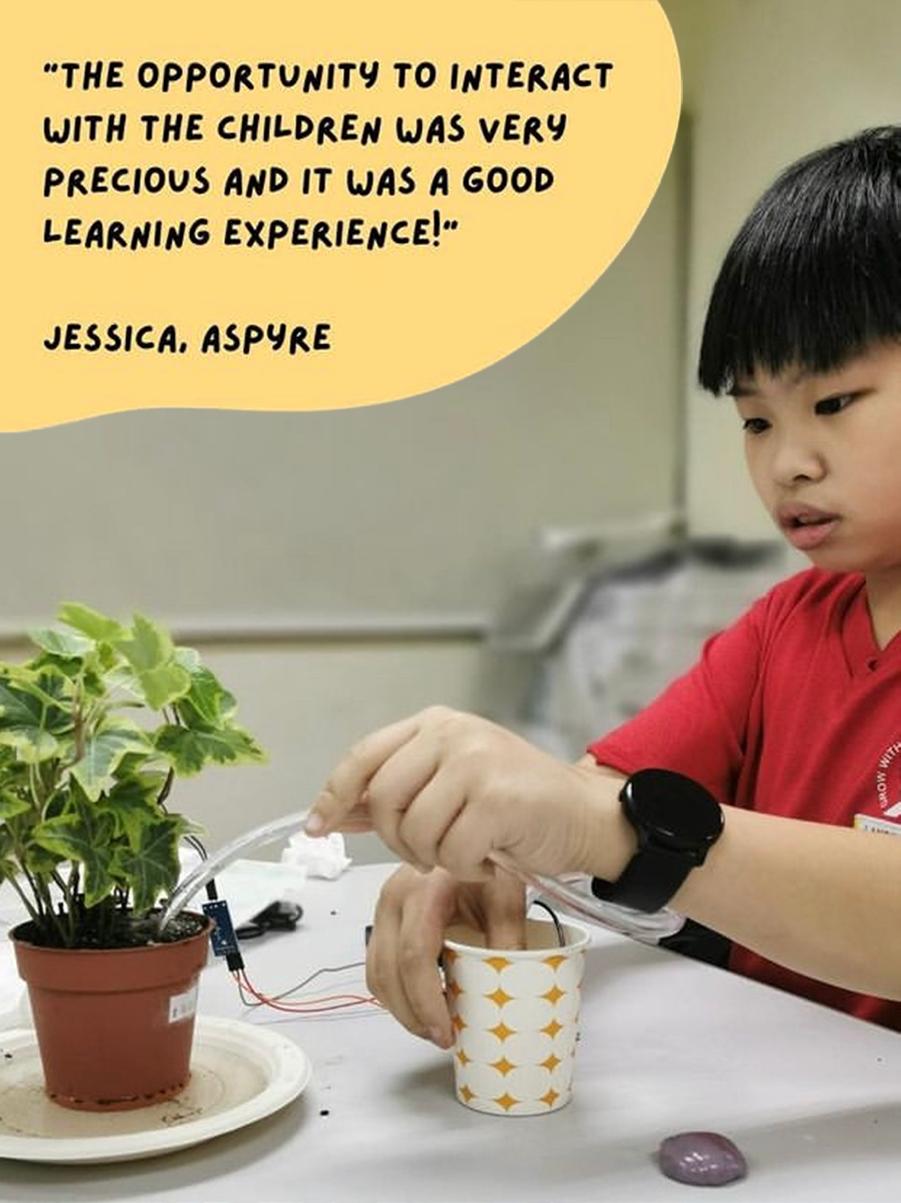
Our primary purpose is to provide a flexible, stimulating curriculum that caters to students’ needs and

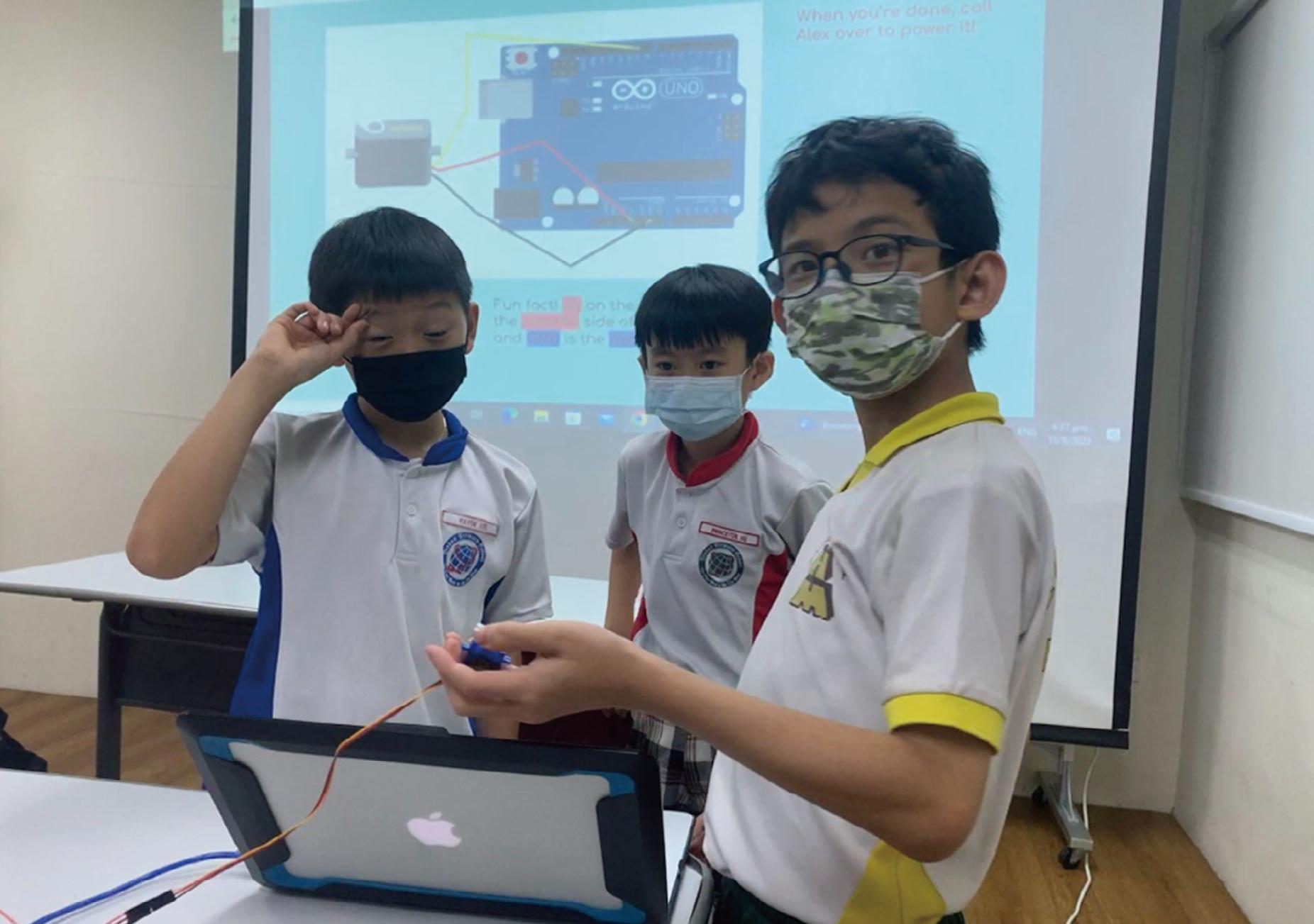
interests, empowering them to experience the joy of learning and applying knowledge in creative ways

We meet every Tuesday after school 3:15-4:00 PM @H305 (Mr. Gaskell’s room)!
If you have any quest ions or want to learn more, feel free to contact our Instagram (@sas.aspyre) or email one of the officers!
22-23 Aspyre Officer Team
Jessica Kang, Hyeonseo Kwon, Alex Tao, Aaron Brest, Nikita Chanda, Rohan Agrawal
92 SPECTRUM VOL.2 93
A Post about Aspyre on Campus Impact's official Instagram! @campusimpactsg
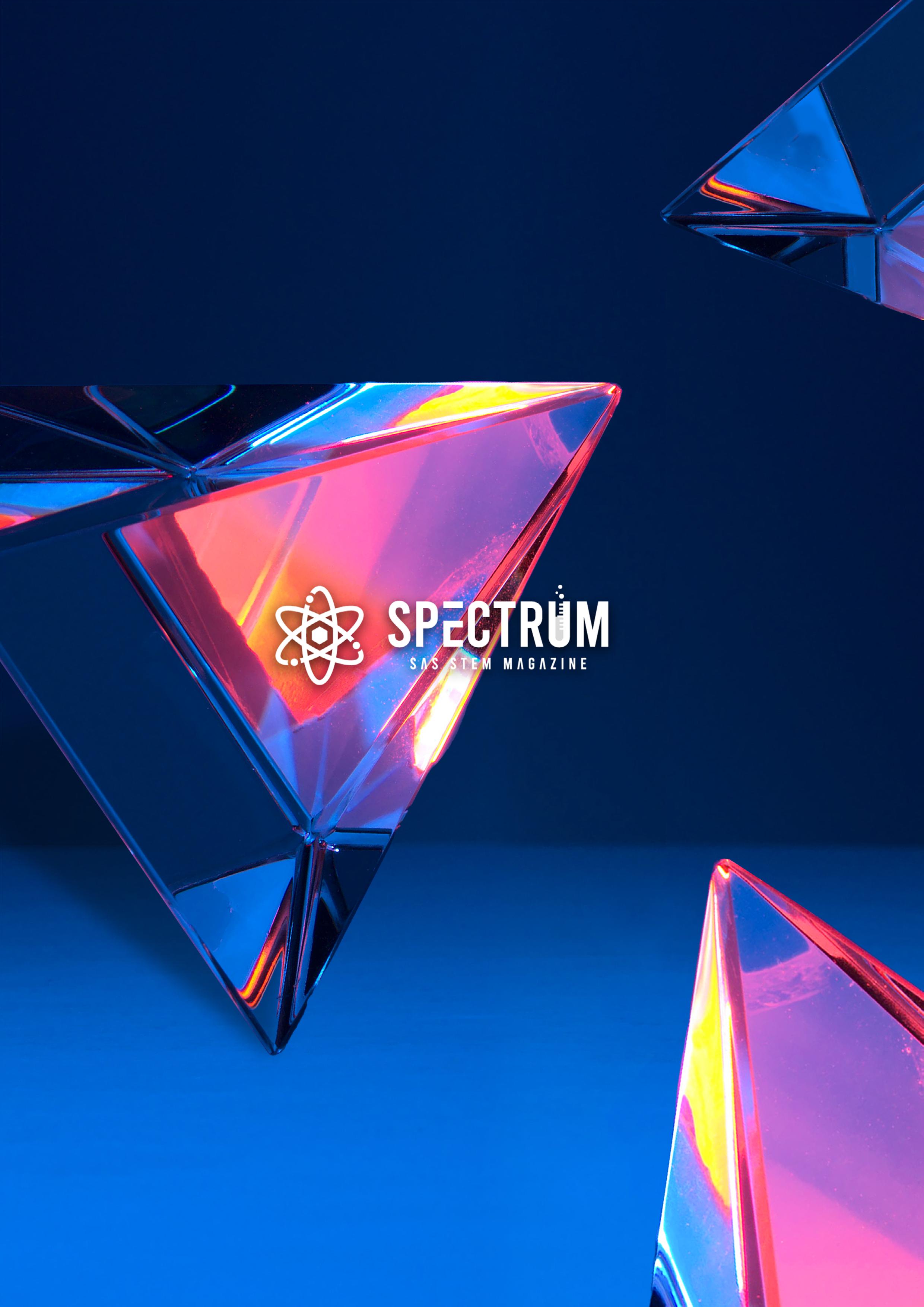
VOL.2 2022 DECEMBER www.spectrumsas.org 94 SPECTRUM VOL.2









 by David Matos on Unsplash
by David Matos on Unsplash






 by Gyulim Jessica Kang
by Gyulim Jessica Kang









 by Ashley Han
by Ashley Han


 by Aaron Brest
by Aaron Brest









 by Rohan Agrawal
by Rohan Agrawal






 by Morgan Ahn
by Morgan Ahn










 by Vyjayanti Vasudevan
by Vyjayanti Vasudevan

 Photo by Mika Baumeister on Unsplash
Photo by Mika Baumeister on Unsplash










 TECHNOLOGY
Quantum Computing: The Future of Technology
Photo by Manuel on Unsplash
TECHNOLOGY
Quantum Computing: The Future of Technology
Photo by Manuel on Unsplash
















 by Lauren Lim
Photo by Lorenzo Herrera on Unsplash
by Lauren Lim
Photo by Lorenzo Herrera on Unsplash


 Photo by Laura Ockel on Unsplash
Making Computers More Like Our Brains
Photo by Krzysztof Kowalik on Unsplash
Photo by Laura Ockel on Unsplash
Making Computers More Like Our Brains
Photo by Krzysztof Kowalik on Unsplash










